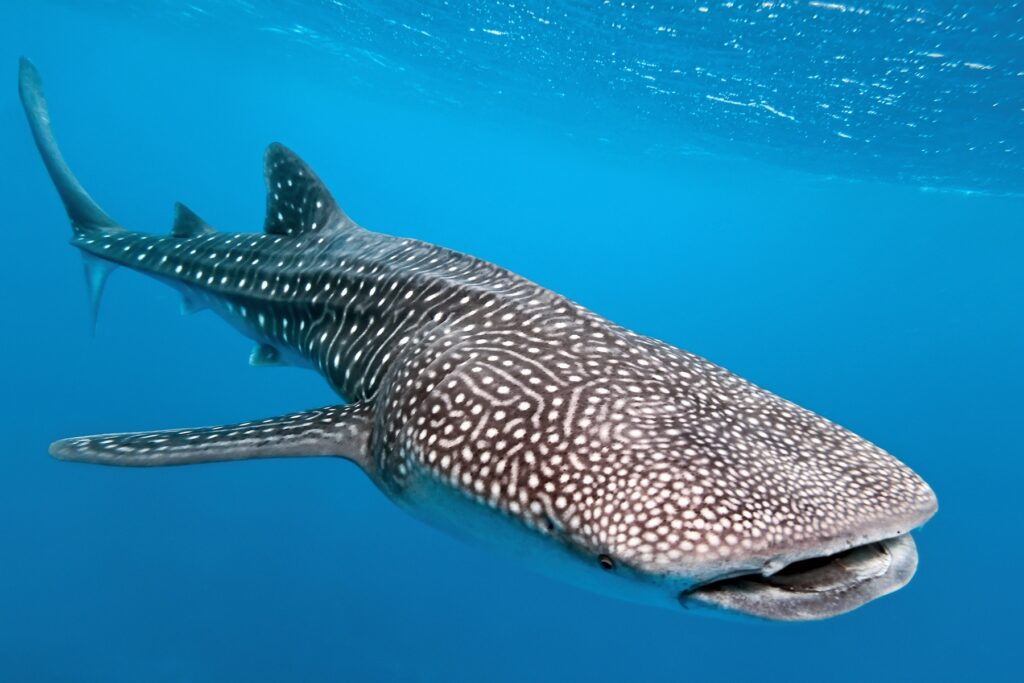- The Philippines is not only a beach paradise, but also one of the most biodiverse places on the planet.
- Located in the heart of the Coral Triangle, the Philippine reefs are home to over 1,800 species of reef fish and 500 species of coral.
Here’s a look at the most colorful, interesting, or commonly seen inhabitants of these underwater gardens of the Philippines. - Most of these fish can be found at a shallow depth. The main thing is to follow simple rules: swim carefully, do not touch anything, do not feed, do not chase.
Class: Actinopterygii (ray-finned fish)
Order: Perciformes
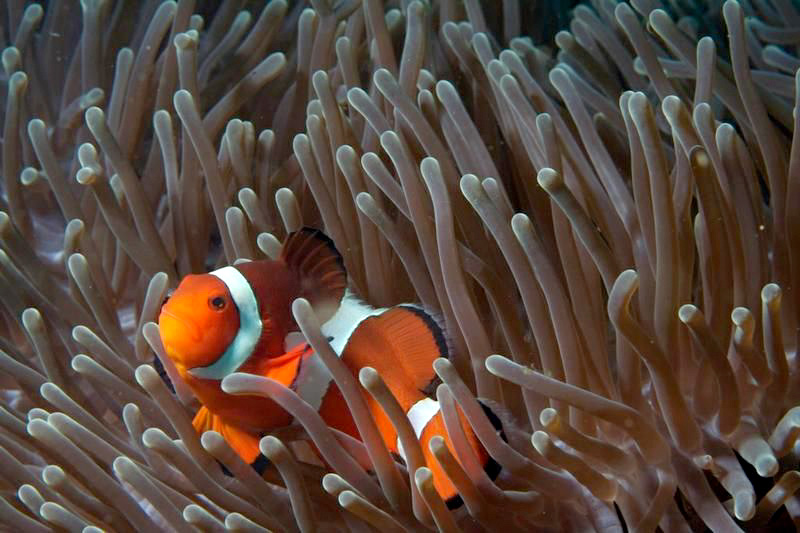
Adults inhabit coral reefs where it lives among the venomous tentacles of large sea anemones. Amphiprion ocellaris and sea anemones have a close, mutually beneficial relationship called symbiosis. Clownfish find shelter and protection from predators in the anemone’s venomous tentacles, and in return help the anemone by driving away butterflyfish and other creatures that might feed on the anemone’s tentacles. Clownfish can also clean the anemone of parasites and food scraps, and attract other fish to the anemone that might serve as food for the anemone. Occur in shallow and calm lagoons.
Ocellaris clownfish typically grow to about 11 cm (4.3 inches) in length, with females generally being larger than males. However, the average size is often around 8 cm (3.15 inches).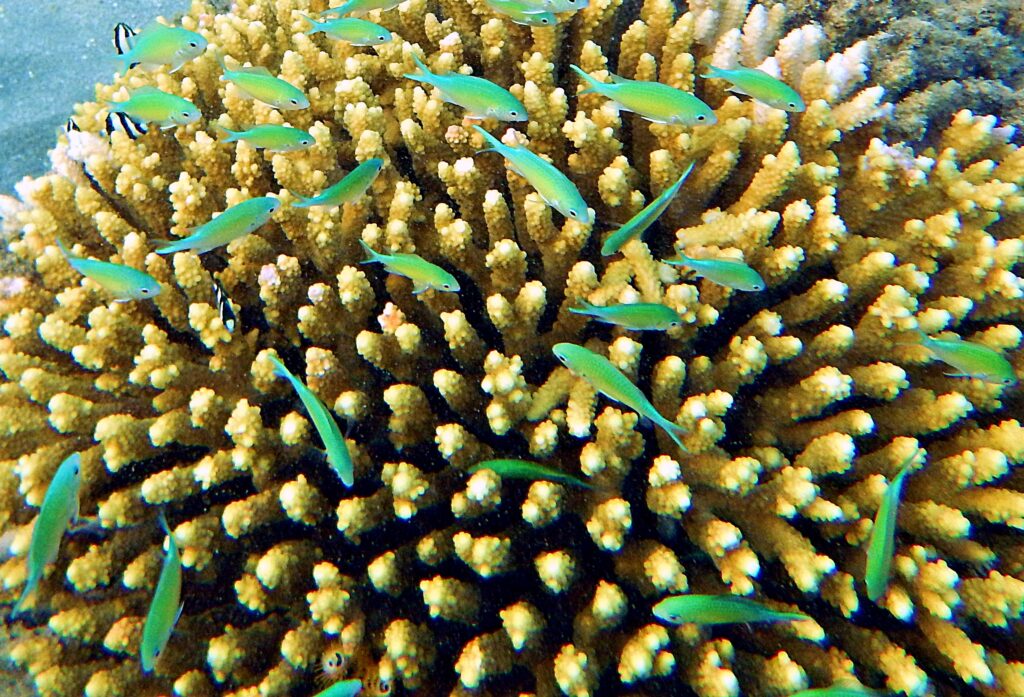
Adults of Chromis viridis live in sheltered areas such as subtidal reef flats and lagoons on depth range from 1 to 20 m.Schools of Chromis viridis can often be seen congregating around Acropora coral heads.
Green Chromis typically reaches a size of 3.9 inches (10 cm).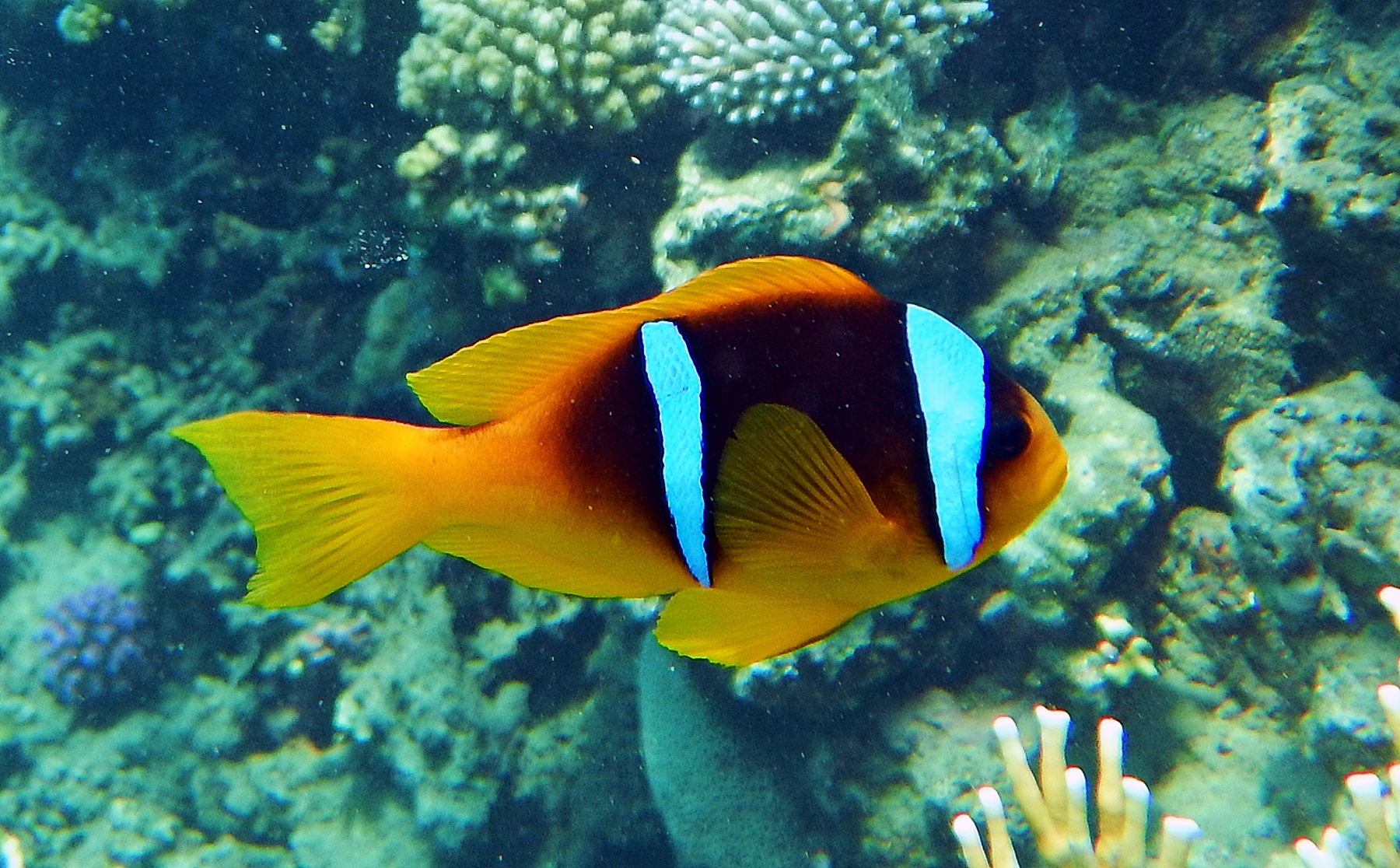
Amphiprion chrysopterus lives in symbiosis with sea anemones (Entacmaea Quadricolor, Heteractis aurora, Heteractis Crispa, etc.), which it takes care of and does not leave the sea anemone in which it lives. The sea anemone protects the clownfish from predators and supplies it with food, such as the remains of sea anemone food, and sometimes accidentally dead tentacles. In turn, the clownfish protects the sea anemone from predators and parasites. In addition, the fish feeds on zooplankton, algae, and small invertebrates.
Adult Orangefin clownfish can reach 10–16 cm in length.
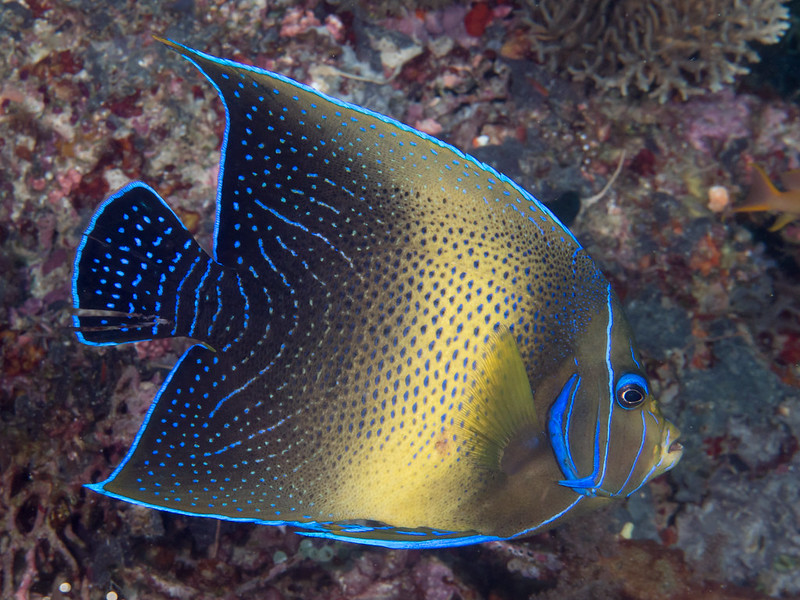
Pomacanthus semicirculatus, or the Semicircle Angelfish, is one of the most impressive marine fishes found on coral reefs. Its juvenile and adult coloration are so different that they were long considered different species! The juvenile coloration is dark blue with white semicircles that disappear over time. It is for these patterns that the fish is called semicirculatus.
The average adult Semicircle Angelfish is 30-40 cm in length.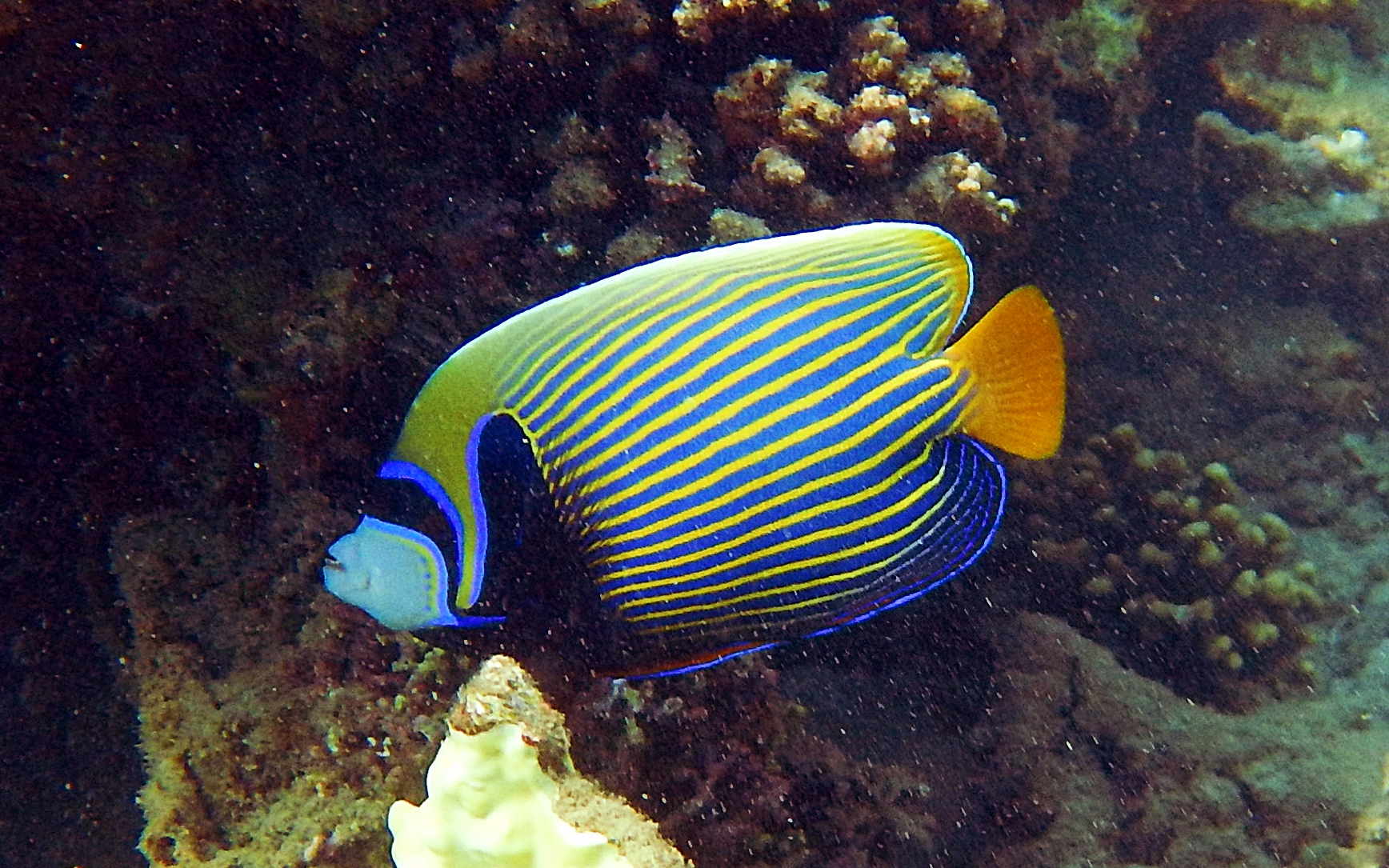
Juvenile Emperor Angelfish are dark blue with concentric blue and white rings, and as they mature, their appearance changes dramatically, becoming striped, with a bright yellow tail and a “mask” over their eyes. This coloring can confuse predators. These fish feed mainly on sponges, tunicates, and other attached organisms, but sometimes eat algae and small invertebrates. Pomacanthus imperator can reach up to 40 centimeters in length.
Here are some great snorkeling and diving spots to see Pomacanthus imperator: Balicasag Island (Bohol) – a marine sanctuary with rich reef life. Apo Island (off Dumaguete) – known for its sea turtles, but Pomacanthus imperator is not uncommon here. Siquijor – shallow reefs with soft and hard corals, where adult emperor angelfish are often found.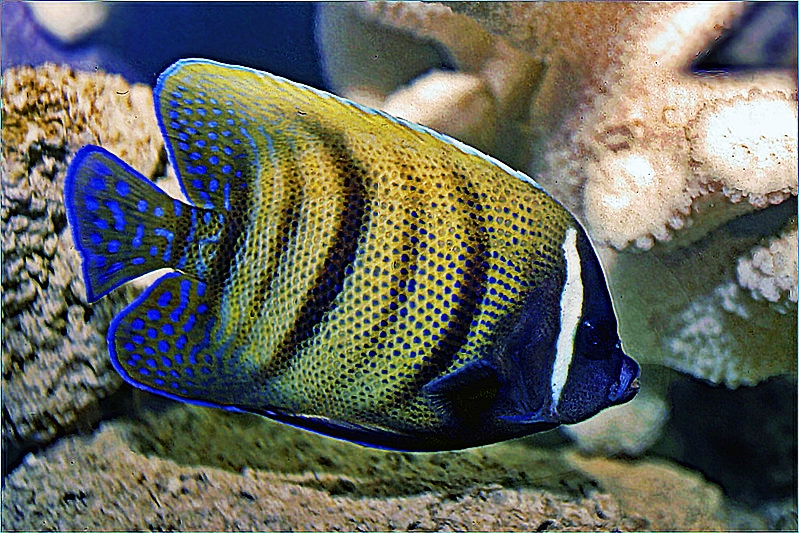
The six-banded angelfish is an omnivorous species, feeding on macroalgae, sponges, and tunicates. It is found in coastal waters, lagoons, and outer reef slopes. Adults live in pairs or solitary in areas with abundant coral growth. When disturbed, it makes loud grunting sounds.
On average, the Sixbar Angelfish measures about 35 cm.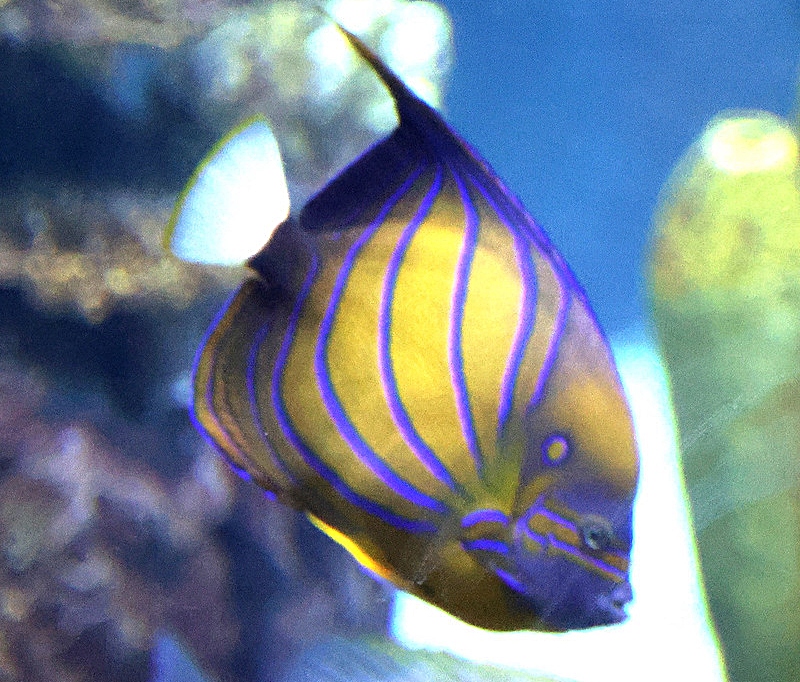
Note the blue ringed spot above the gill cover – that’s why this species of angelfish is called Blue-Ringed Angelfish.Pomacanthus annularis lives on coastal reefs up to a depth of thirty meters. It is known for its bright coloration, which, like many other Pomacanthidae, changes from juveniles to adults.
Adults of this fish are often found in pairs in caves, while juveniles settle in very shallow areas near the shore, where short filamentous algae grow on rocks or dead corals. Bluering angelfish feeds on sponges and tunicates.
Pomacanthus annularis can reach sizes of up to 45 centimeters, but usually grows to 35 centimeters.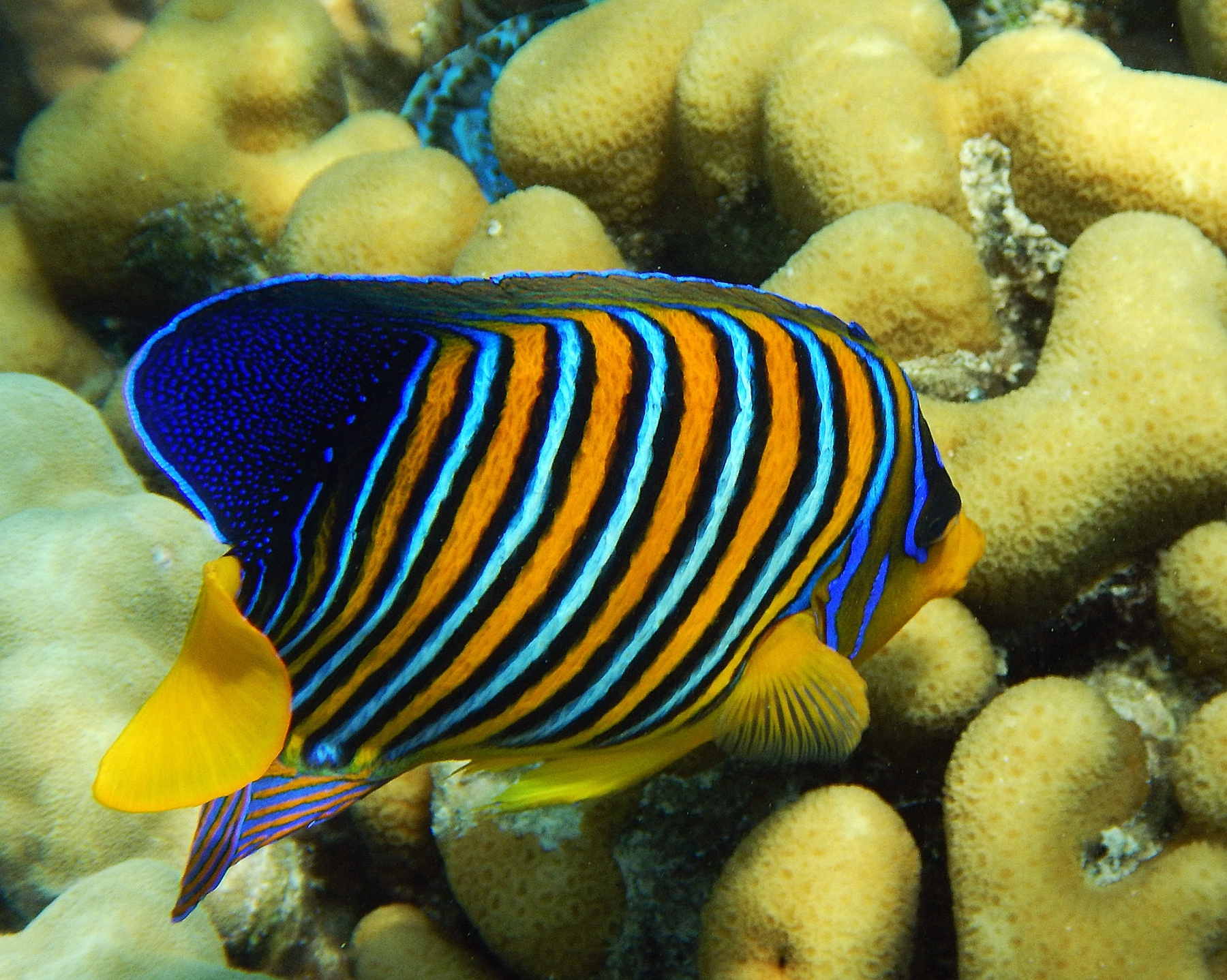
Royal angelfish is a carnivorous species that feeds on sponges and tunicates located throughout reefs and underwater caves. Therefore, Pygoplites diacanthus is often found near coral caves.
The royal angelfish can reach a maximum length of 25 cm (about 9.8 inches) and this fish is considered to be harmless to humans.
In the Philippines they are found in various locations, including Puerto Princesa (Palawan), San Juan (Batangas), Calatagan and Nasugbu, Lanuza Bay, Bongo Island, Paril-Sangay Protected Seascape, Moro Gulf, Sarangani Bay, Malalag Bay, Dauin-Apo Island, and Bantayan Island (northern Cebu).
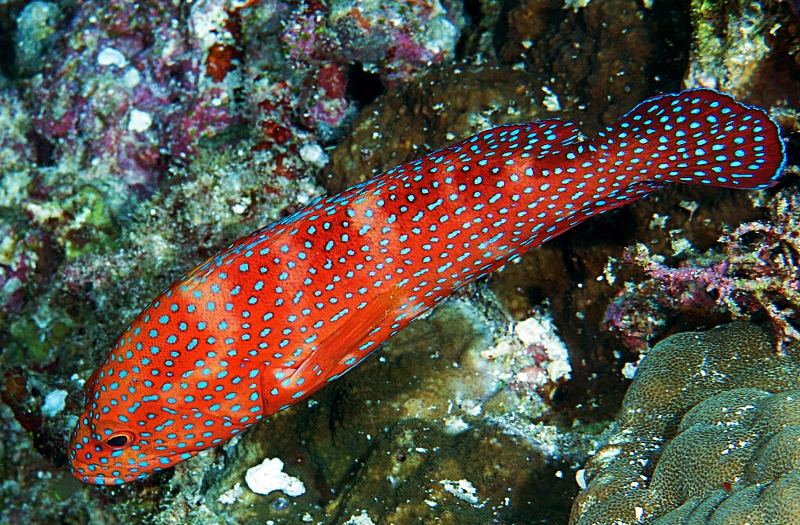 Groupers are teleosts fish, typically with a stout body and large mouth, and are not adapted to swimming fast over long distances.Cephalopholis miniata, can reach a maximum total length of 50 cm.Groupers are predators that feed mainly on fish, crustaceans and even octopuses. Some species of Groupers prefer to ambush their prey, while others are active predators.
They swallow prey rather than biting pieces off of them.
Groupers are teleosts fish, typically with a stout body and large mouth, and are not adapted to swimming fast over long distances.Cephalopholis miniata, can reach a maximum total length of 50 cm.Groupers are predators that feed mainly on fish, crustaceans and even octopuses. Some species of Groupers prefer to ambush their prey, while others are active predators.
They swallow prey rather than biting pieces off of them.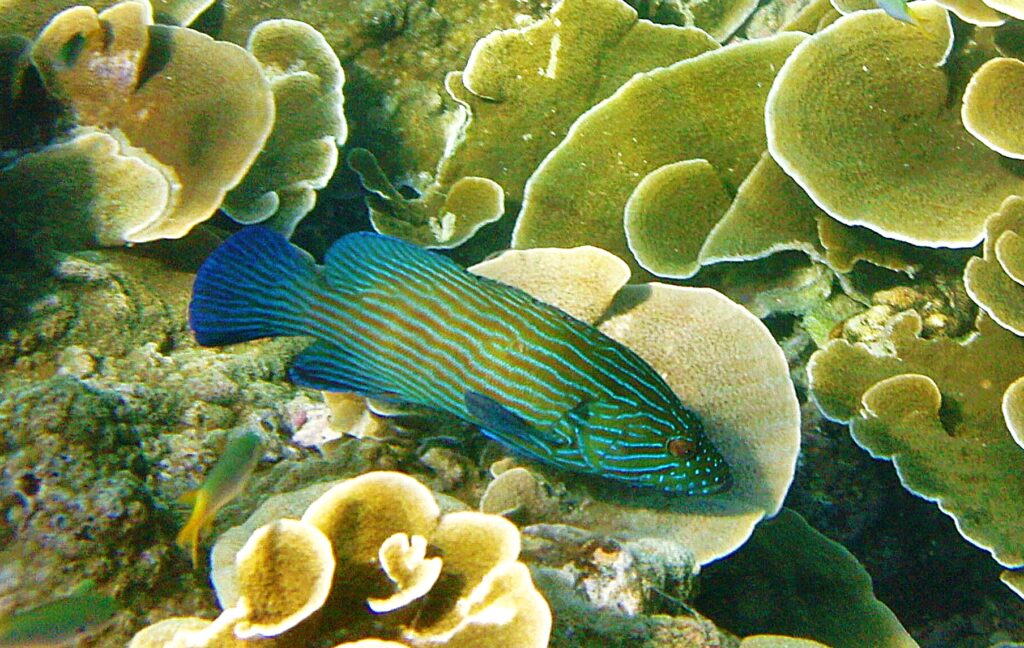 Cephalopholis formosa is a predatory species that feeds on other fish and crustaceans. It is a solitary species. This species is most often found in shallow waters over muddy or dead reefs at depths ranging from 5 to 30 meters.The maximum total length of Cephalopholis formosa is 34 centimeters (13 inches).It can be found while diving in a variety of locations including Puerto Galera, Coron, Tubbataha Reef, Apo Island, and Malapascua.
Cephalopholis formosa is a predatory species that feeds on other fish and crustaceans. It is a solitary species. This species is most often found in shallow waters over muddy or dead reefs at depths ranging from 5 to 30 meters.The maximum total length of Cephalopholis formosa is 34 centimeters (13 inches).It can be found while diving in a variety of locations including Puerto Galera, Coron, Tubbataha Reef, Apo Island, and Malapascua.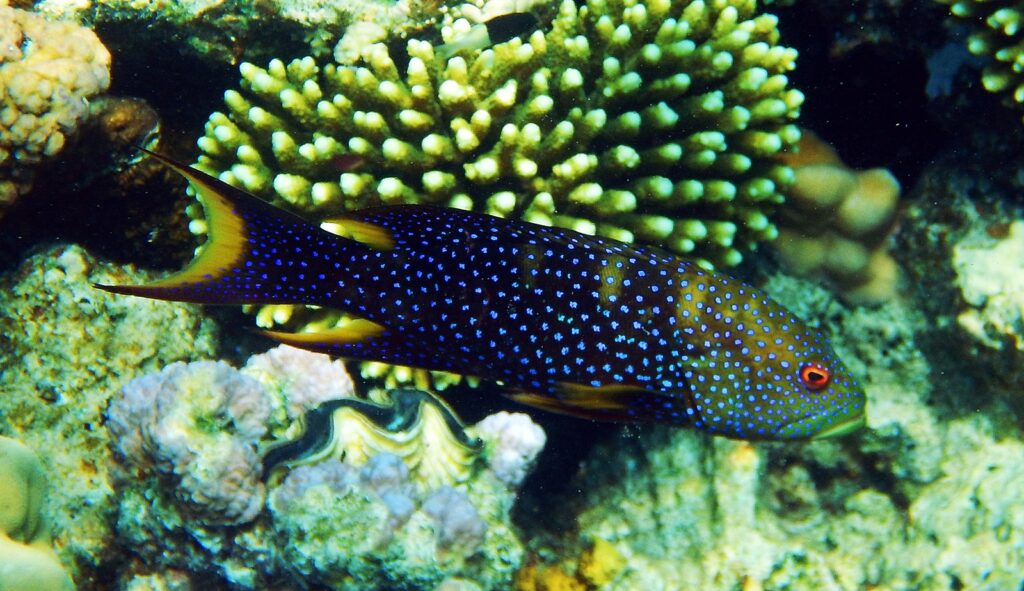 Variola louti is a predator, feeding mainly on fish, crabs, shrimp and crustaceans. It leads a solitary and territorial lifestyle, and is especially aggressive towards other predators.The yellow-edged lyretail can reach a maximum total length of 81 cm.
Variola louti is a predator, feeding mainly on fish, crabs, shrimp and crustaceans. It leads a solitary and territorial lifestyle, and is especially aggressive towards other predators.The yellow-edged lyretail can reach a maximum total length of 81 cm.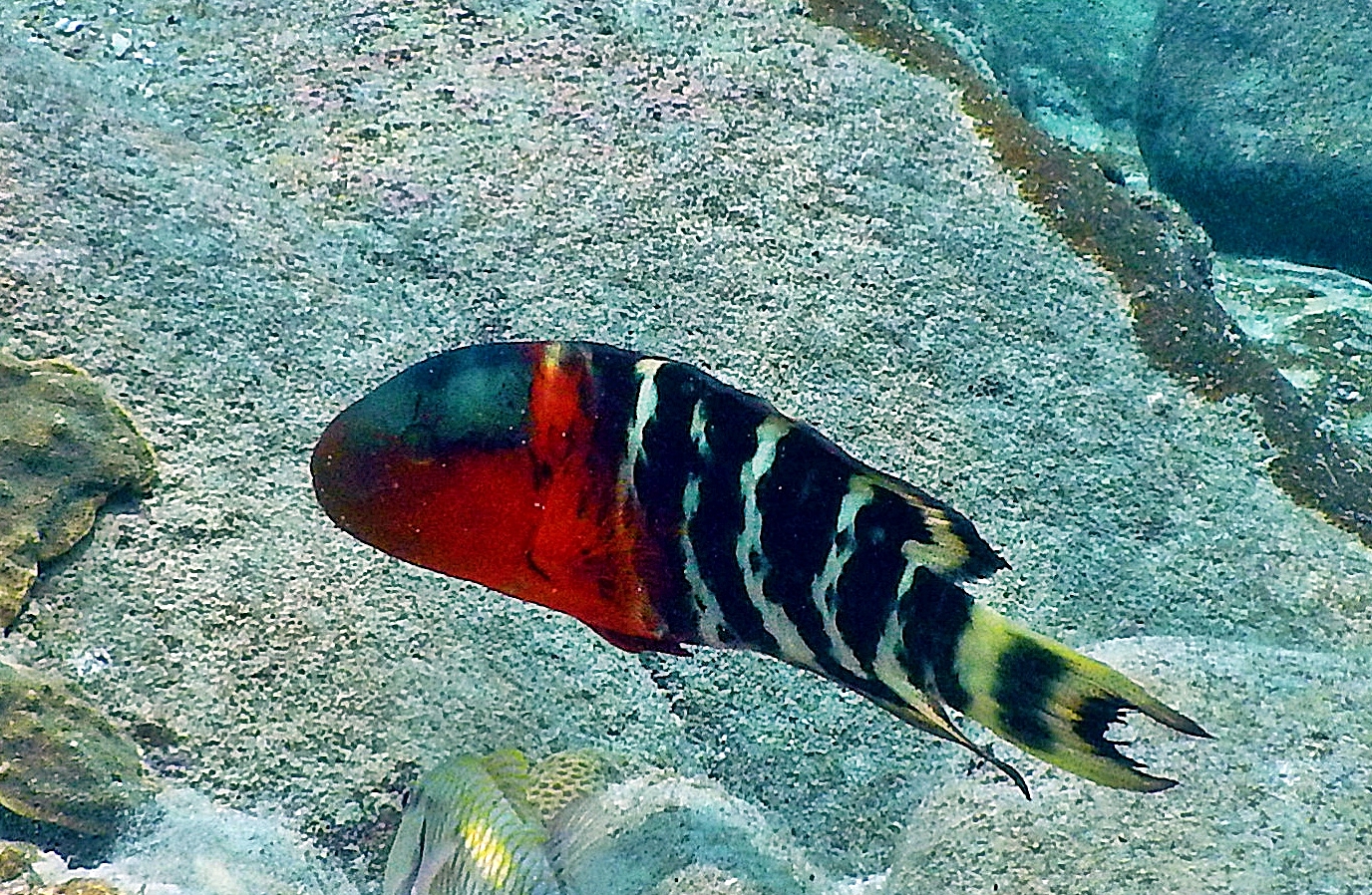
The genus name of these cute fish comes from the Greek word “cheilos” – lip, which refers to the protruding lips and powerful jaw. The red-breasted wrasse is considered a solitary fish and lives in seaward lagoons and reefs at depths of 4 to 60 m. It feeds mainly on crustaceans, sea urchins, hard invertebrates and mollusks, the shells of which it splits with its powerful jaws. This species can reach a maximum length of 40 cm (16 in).
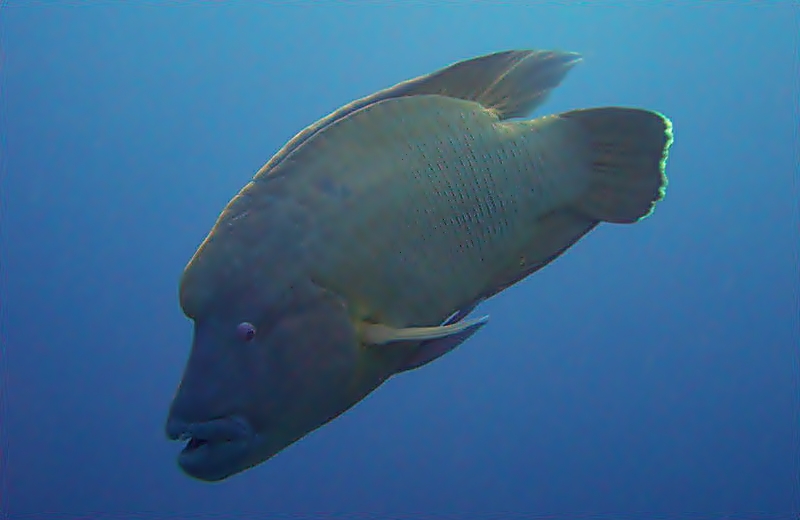
The humphead wrasse, also known as the Napoleon wrasse, is a large, distinctive fish found in coral reefs throughout the Indo-Pacific region. It’s characterized by its large size, reaching up to 7 feet (213 cm) in length, a prominent hump on its forehead, and thick lips.
They are predators, feeding on hard-shelled prey like mollusks, starfish, and crustaceans, and are known to consume even toxic animals like sea hares and crown-of-thorns starfish.Humphead wrasse are classified as endangered due to overfishing and habitat loss, particularly related to the live reef fish trade.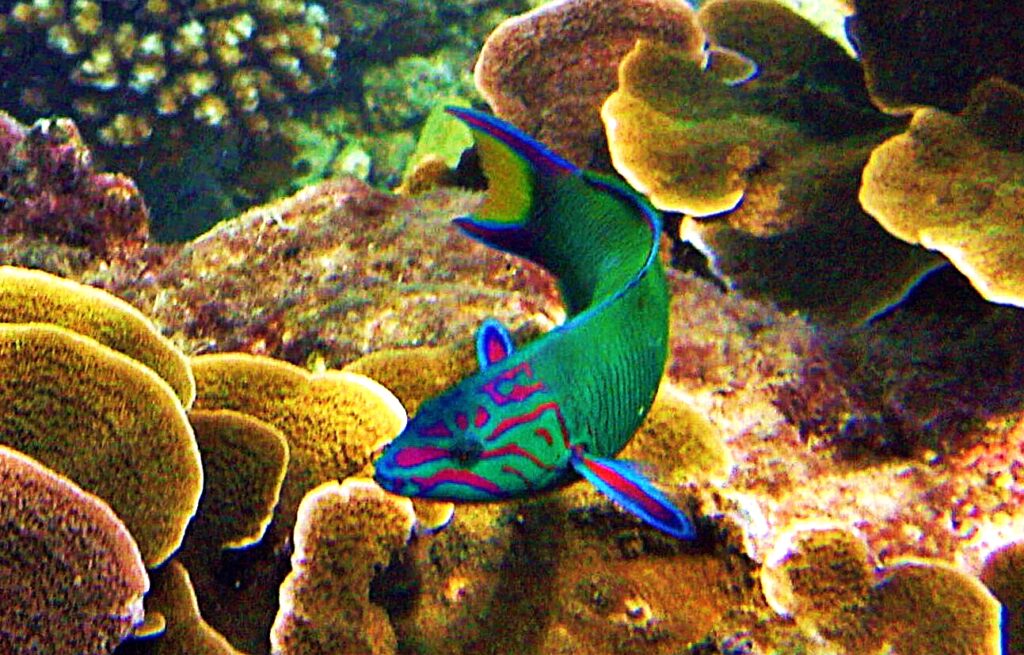
Thalassoma Lunare is found singly or in groups in the upper parts of lagoons and coastal reefs, as well as on protected reefs facing the sea. It is usually found in the upper parts of ledges and capes.
The Moon wrasse can grow up to 45 cm (18 inches) in length. It feeds mainly on small bottom invertebrates and fish eggs. During its life, it changes its sex from female to male.Thalassoma is a territorial fish and has an aggressive nature. And you can see for yourself how active and mobile this fish is.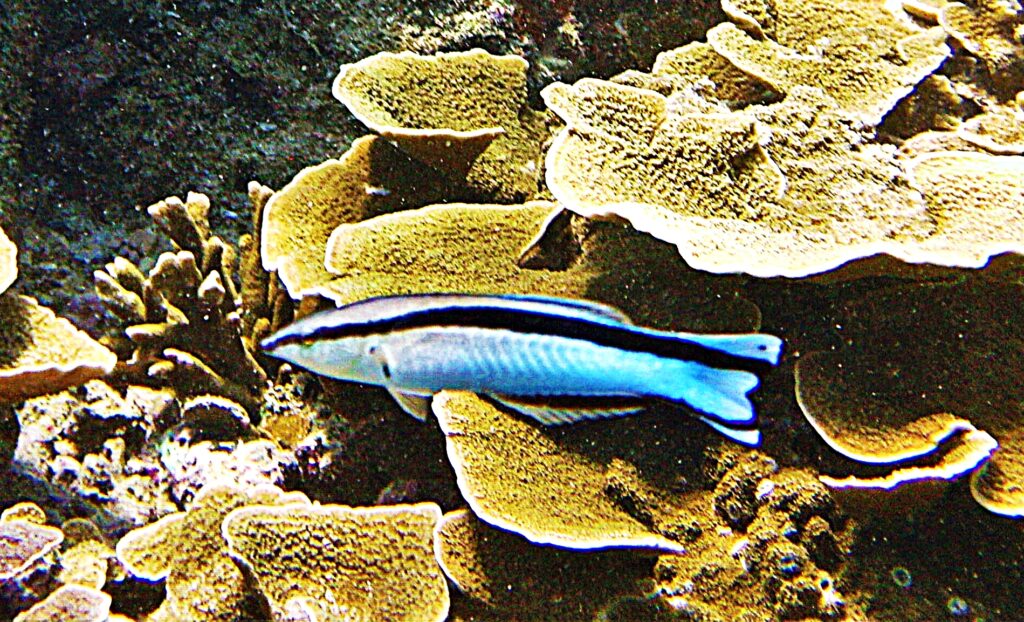
This is a small fish with an elongated body, a bluish coloration and a distinctive black stripe along its body.
Cleaner wrasse, is a fish known for its role as a coral reef cleaner, removing parasites and dead tissue from the skin of other fish. They live in a symbiotic relationship with other marine life, providing them with cleaning services and receiving food and protection in return. Divers can often see other fish patiently presenting their sides to the cleaner wrasse while it plucks parasites from their skin.Labroides dimidiatus, typically reaches a maximum length of 14 cm (5.5 inches).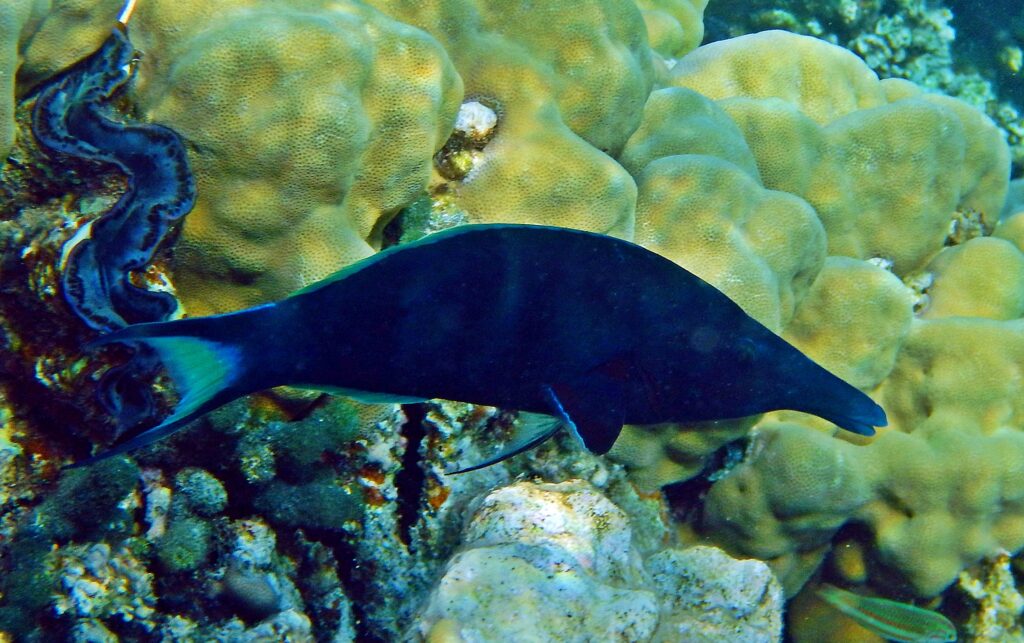
Males of these fish are usually dark blue or blue-green, and females are lighter, with a brownish-green tint. The color can change with age and depending on gender. The size of the Bird Wrasses is up to 25 cm in length, but there are also larger ones.
Bird Wrasses are a real gourmet among reef dwellers. Its diet reflects its “toolkit”: a long snout, powerful jaws and tenacious teeth help it extract food from the most inaccessible crevices of the coral reef. Here are its favorite delicacies: shrimp, amphipods, crabs and amphipods, snails and sea worms, which it fishes out of coral cracks.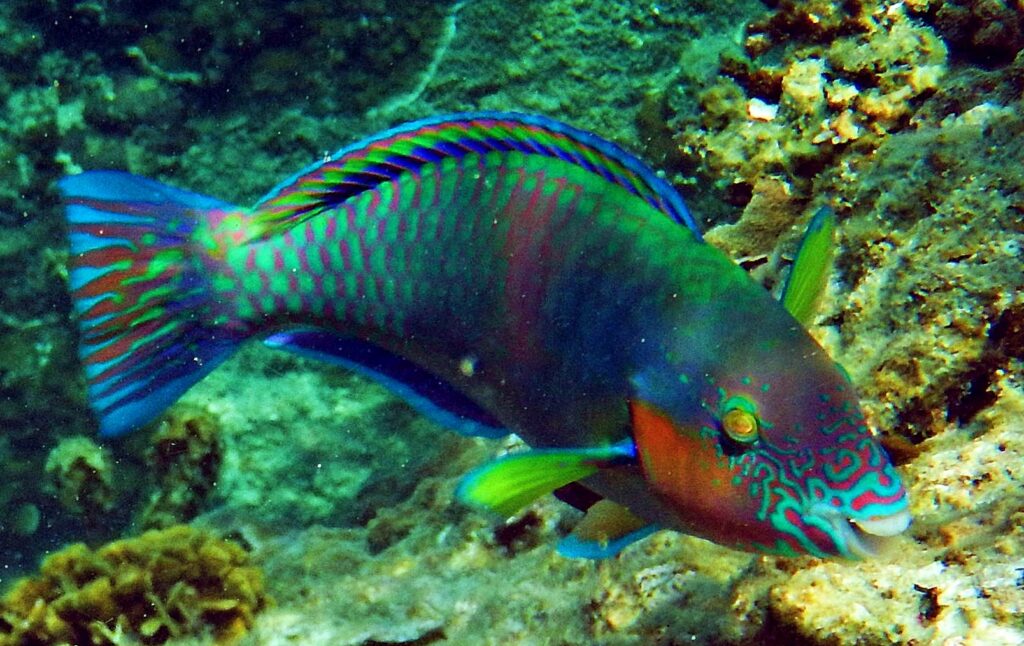
This fish is found in muddy coastal and marine areas at depths of up to 20 m. It lives on rocky and coral reefs from tidal pools to depths of at least 10 m. It forms schools of 30–40 individuals.
It feeds on benthic algae and corals.Scarus rivulatus typically reaches a maximum length of 40 cm (16 inches). It does not pose any danger to the snorkeler upon encounter.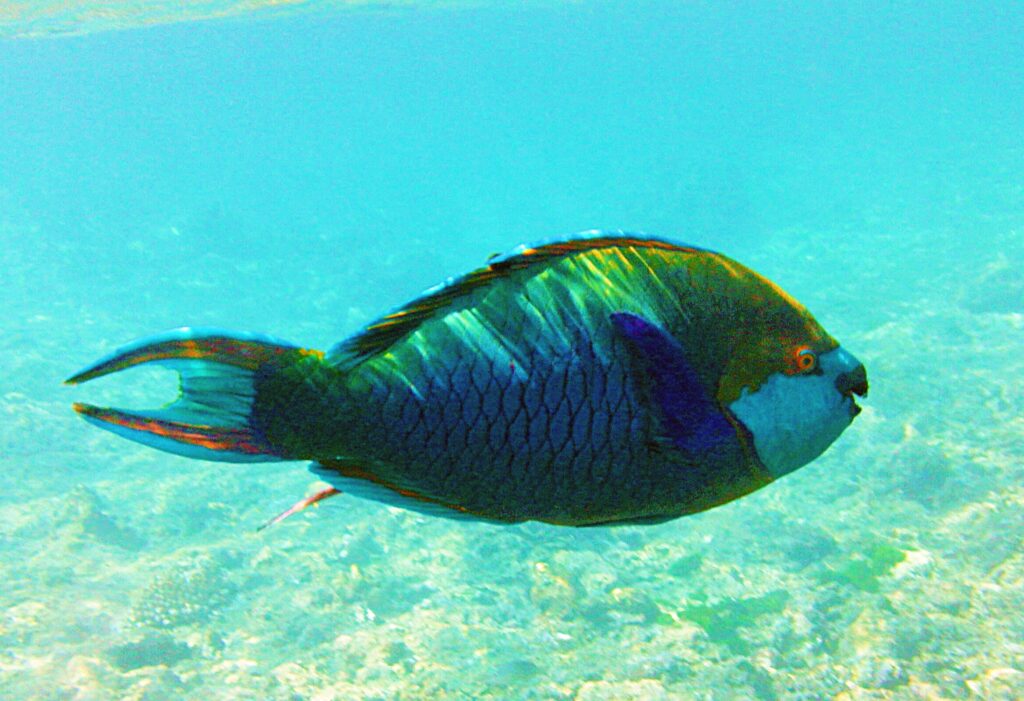
Found on seaward slopes and reef shallows. Usually found on outer reefs, but may enter shallow water in sheltered areas. Feeds on seaweed living on the bottom. Often found in large schools.
In Scarus prasiognathos, the most common individuals are between 20 and 30 cm in length, with the maximum recorded size being 70 cm.
The fish does not pose a danger to humans.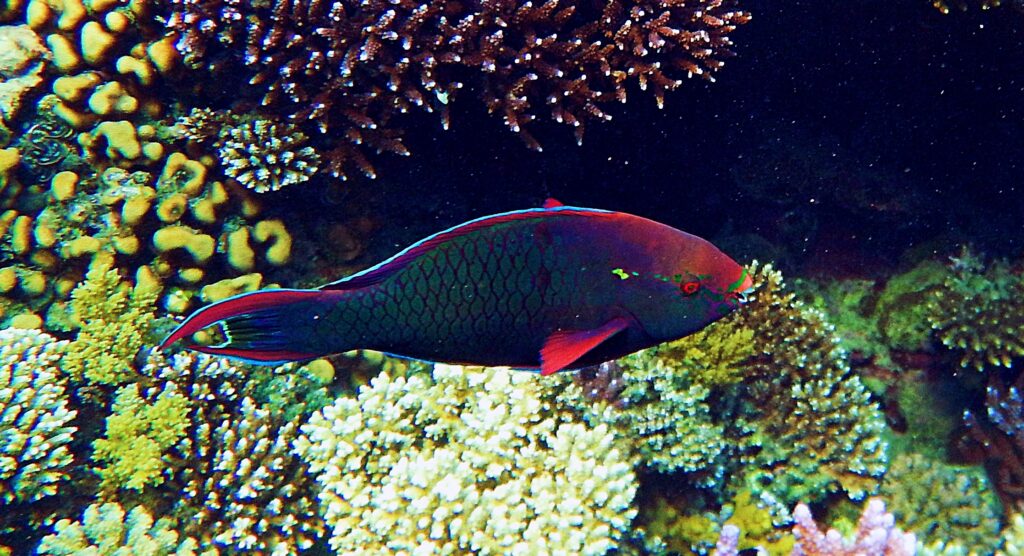
The dusky parrotfish is often solitary, but males may also live in a small group of mating females. This fish is primarily herbivorous, and its main food source is benthic algae.
The Dusky parrotfish, Scarus niger, can grow up to 44.4 cm (17.5 inches) in total length.
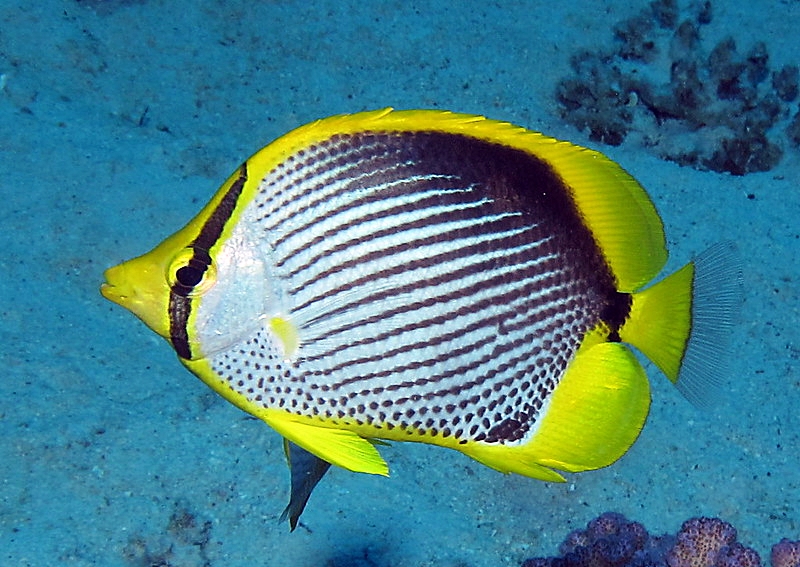
Chaetodon melannotus is characterized by its vibrant yellow body and distinctive black dorsal patch. These fish are reef-associated, meaning they live near coral reefs, and are known for their strong pair bonds and tendency to swim in pairs.
They are also known to be omnivores, feeding on coral polyps, small invertebrates, and other food found among the coral and in the reef environment.The typical length of Chaetodon melannotus is often less than 18 centimeters (7 inches).
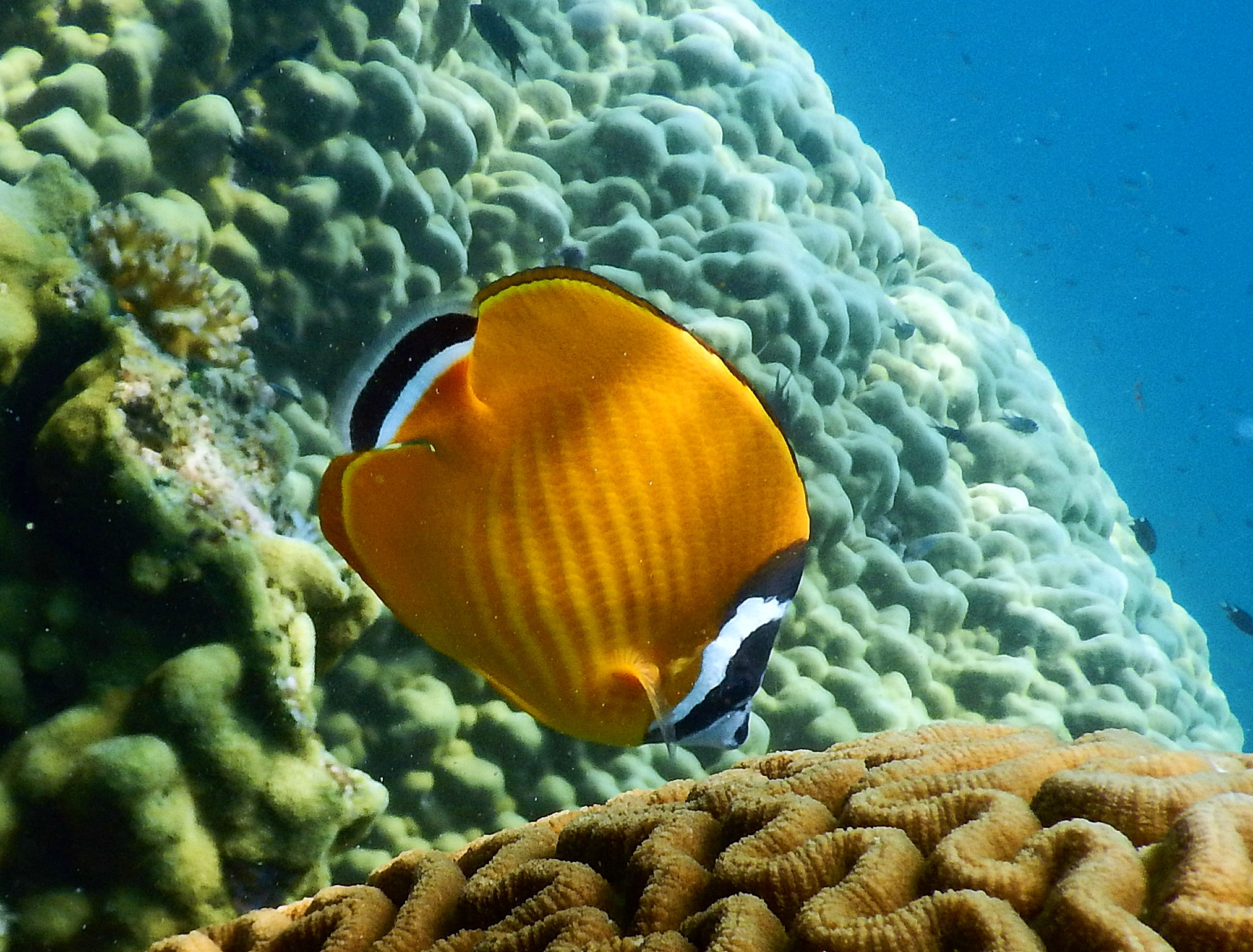
Hong Kong butterflyfish live in rocky areas and on coral reefs, where they are found in pairs and small groups. They typically form monogamous pairs.
Chaetodon wiebeli feed on algae, coral polyps and benthic invertebrates.
These fish grow up to 19 cm in length.
Chaetodon auriga are omnivorous and feed on a variety of small invertebrates, coral polyps, and algae. In the wild, they often form pairs and are known to be monogamous.
The threadfin butterflyfish prefers coral reefs, but can also be found on other types of bottoms, such as muddy and rocky areas.Chaetodon auriga, typically reaches a maximum size of 23 cm (approximately 9 inches).
Pennant fish live in pairs and feed on zooplankton from the water column, coral polyps and sometimes bottom invertebrates.
Juveniles are solitary and can feed by cleaning other fish.The average size of Heniochus acuminatus observed in the wild is typically around 15 cm (6 in) in total length.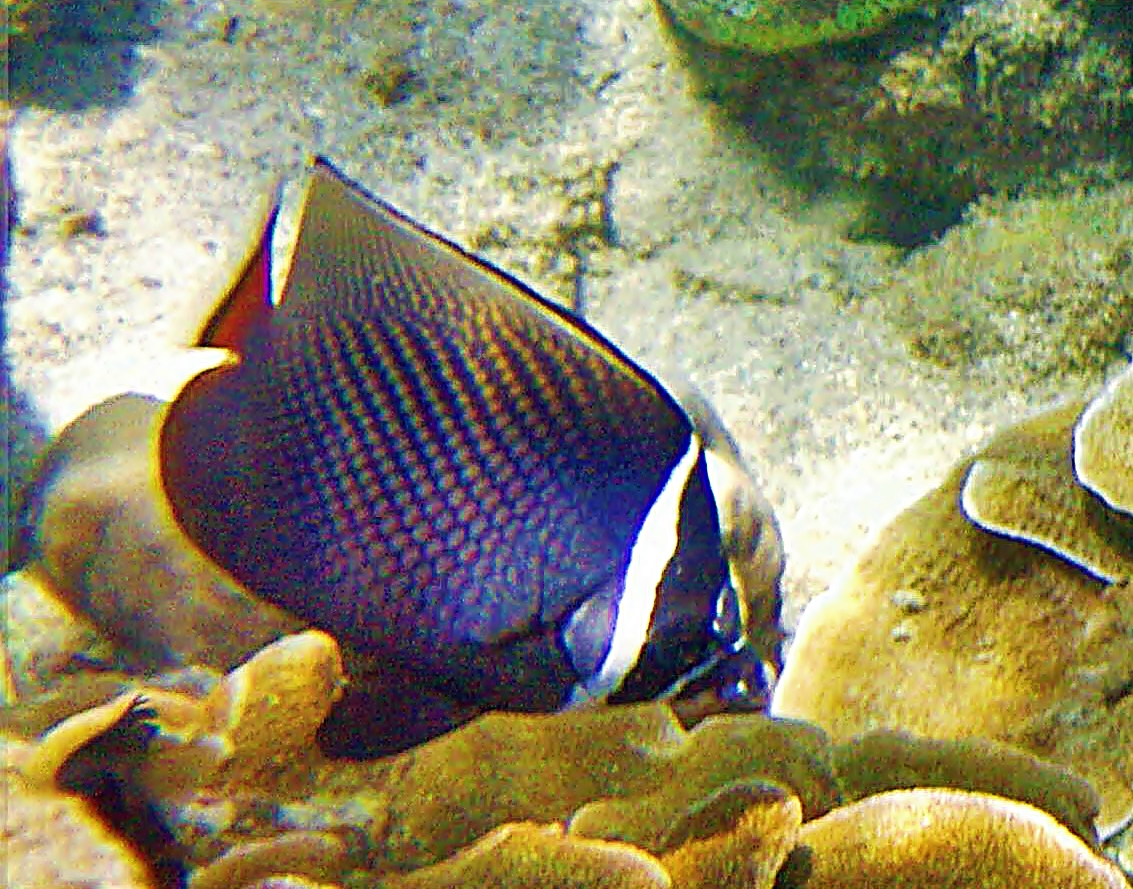
Redtail butterflyfish are often found on coral reefs in pairs or several aggregations.
It usually swims at depths of between 3 and 15 m.The basis of this fish’s diet consists of coral polyps.
It can grow to 18 cm (over 7 in) in length.Pterois volitans (Common Lionfish) 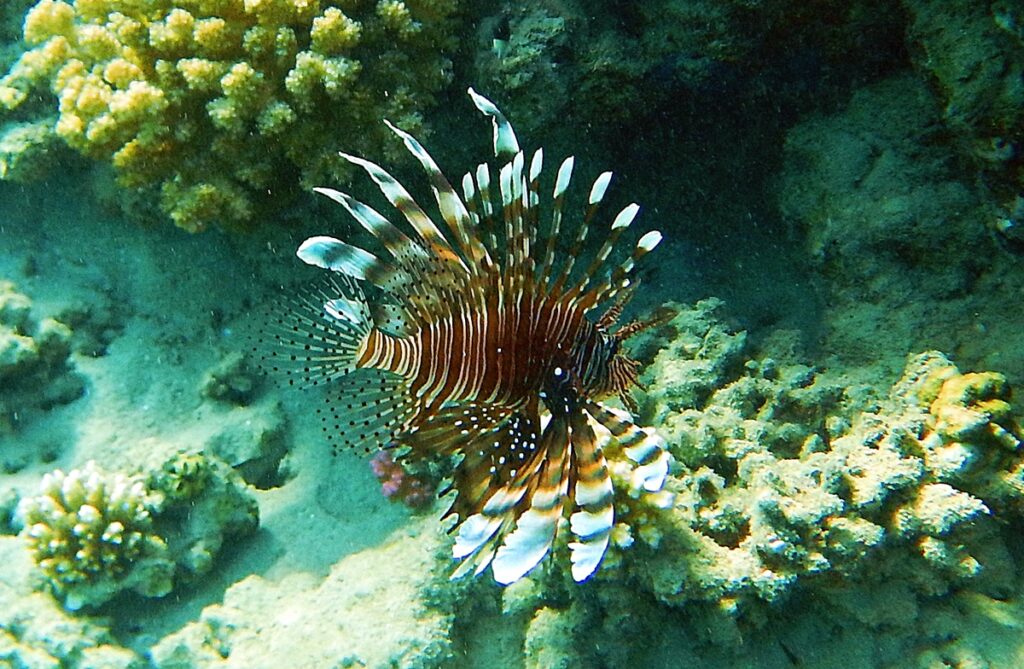
- Pterois volitans has a red body with numerous light stripes. This fish is characterized by large pectoral fins. Lionfish are predatory fish. They can easily swallow fish up to two-thirds their own length (typically grow to around 30 cm).
- Lionfish have long ribbons of dorsal and pectoral fins – these luxurious fan-shaped fins hide sharp poisonous needles. A prick from the spines of this fish is very painful – the poison can cause convulsions and paralysis, and necrosis or sepsis occurs at the puncture site. Sometimes, as a result of such a prick, a person loses consciousness.
- One diver recalled that a lionfish suddenly darted toward him, literally “leaped” toward him, when he approached it.
In fact, I have personally observed how a lionfish, hunting, slowly swam along the bottom, and then suddenly “leaped” forward to grab its prey.
Order: Acanthuriformes
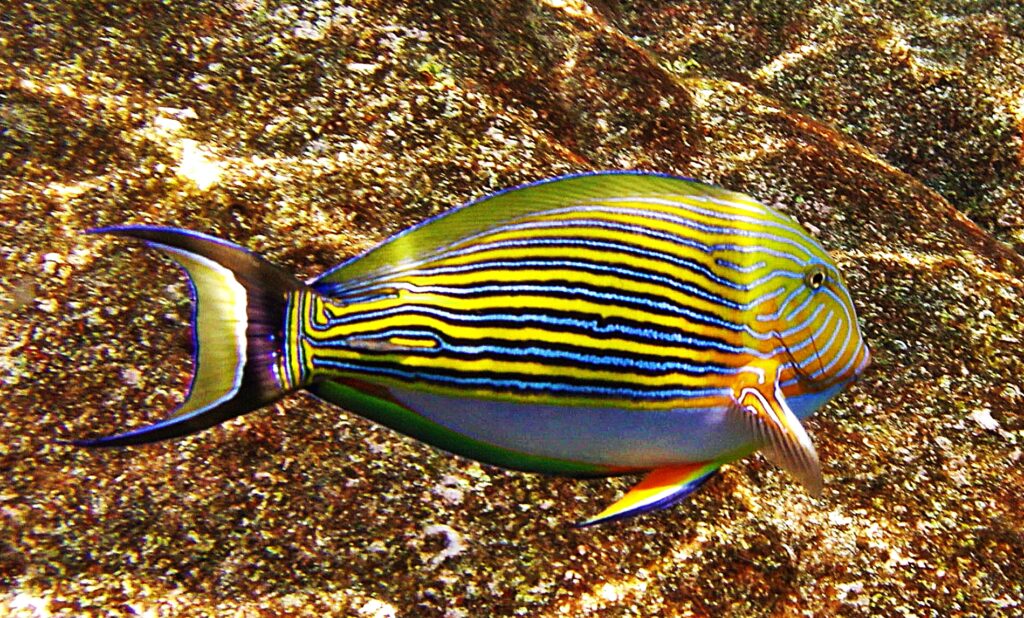
The lined surgeonfish is associated with reefs, living in marine waters just a few meters deep.The fish is territorial, with a large male defending a feeding area and a harem of females. Adults may also form schools and will aggregate during spawning. Juveniles are solitary.
The fish is primarily herbivorous, but may occasionally eat crustaceans. Most of its diet consists of algae. It grazes during the day.
The Lined Surgeonfish can reach a maximum length of 38 centimeters (15 inches).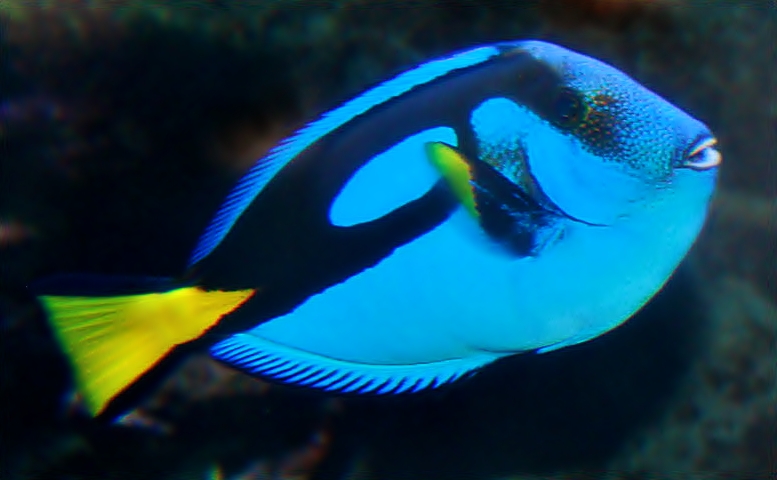
Paracanthurus hepatus typically reaches a maximum length of 31 cm (12 inches), feeds mainly on algae and plankton.
Blue tang is a very popular fish among aquarists, which became famous after the release of the cartoon Finding Nemo and its sequel Finding Dory.
Blue tangs may look relatively harmless, but when threatened, they extend a pair of razor-sharp, poisonous spines on either side of their tail. The fish then begins to move its body from side to side, threatening predators with its poisonous stings.
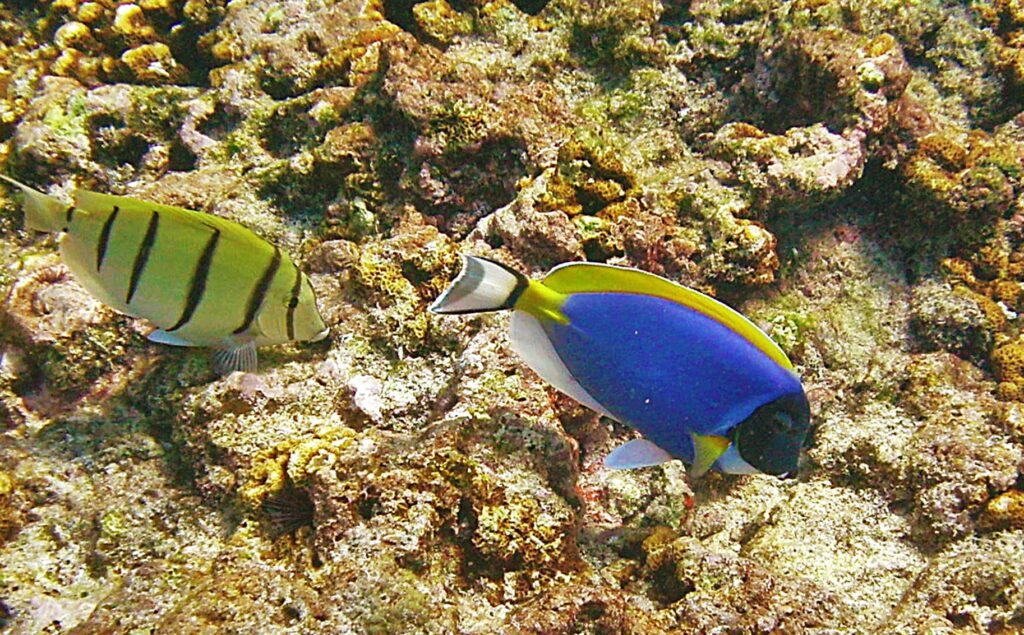
Powderblue surgeonfish are known for their vibrant blue coloration and distinctive black mask across their head. This species is is herbivorous and eating mostly benthic algae. Powderblue surgeonfish has a diurnal activity.
This fish is territorial and aggressive with other surgeonfish.
Acanthurus leucosternon, typically, reaches a size of 23 cm (around 9 inches) in length.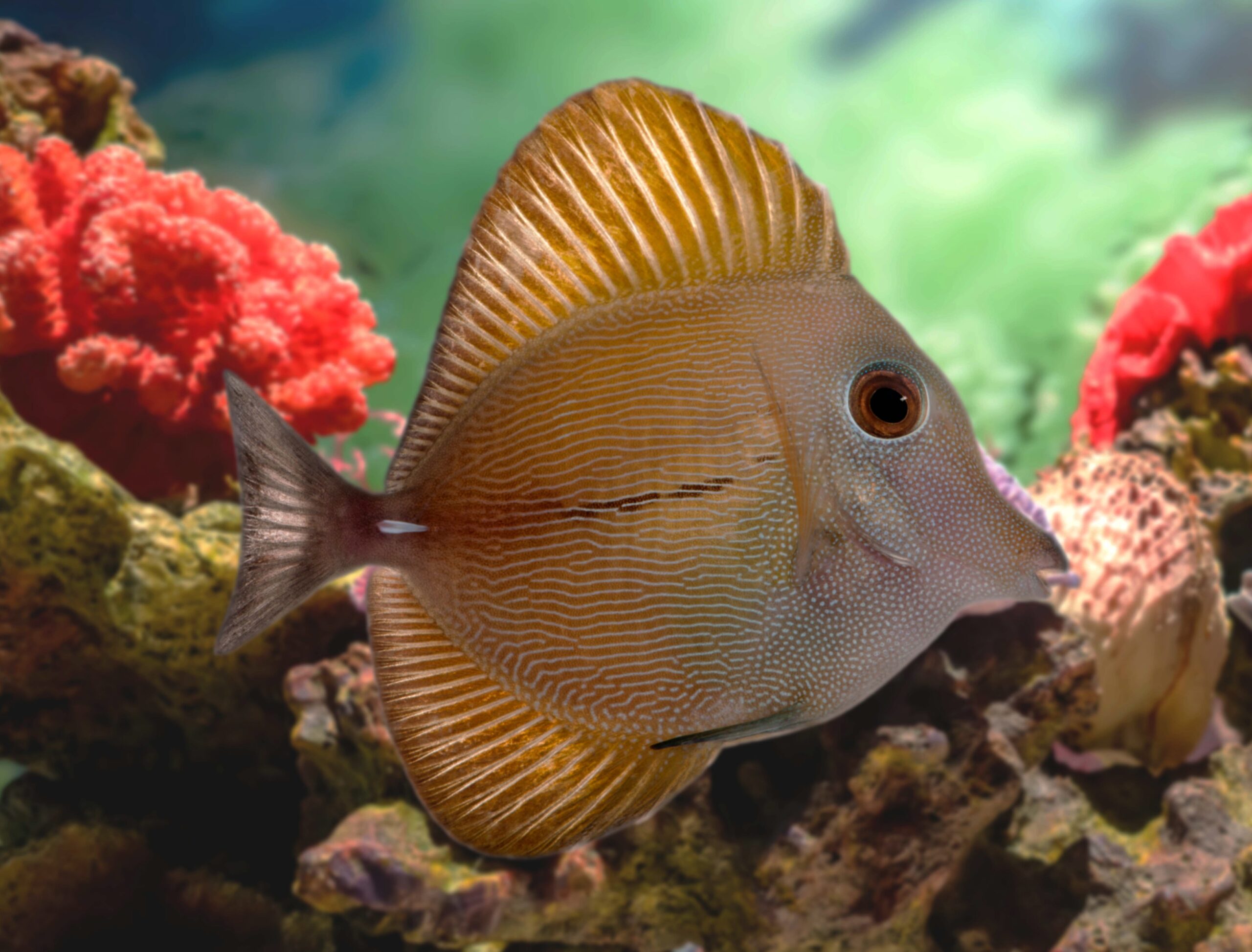
This fish is usually found almost everywhere, on all the reefs of the Philippines on the exposed side of reefs and in coral-rich lagoons where it feeds on algae.
Juveniles can be territorial, and adults often form groups.Males of this species display mating behavior by changing color and dancing to attract females. To spawn, the fish rush to the surface, fertilization occurs externally, and the eggs are scattered throughout the water column.
According to publications, Zebrasoma scopas can grow to a maximum length of 40 centimeters (16 inches).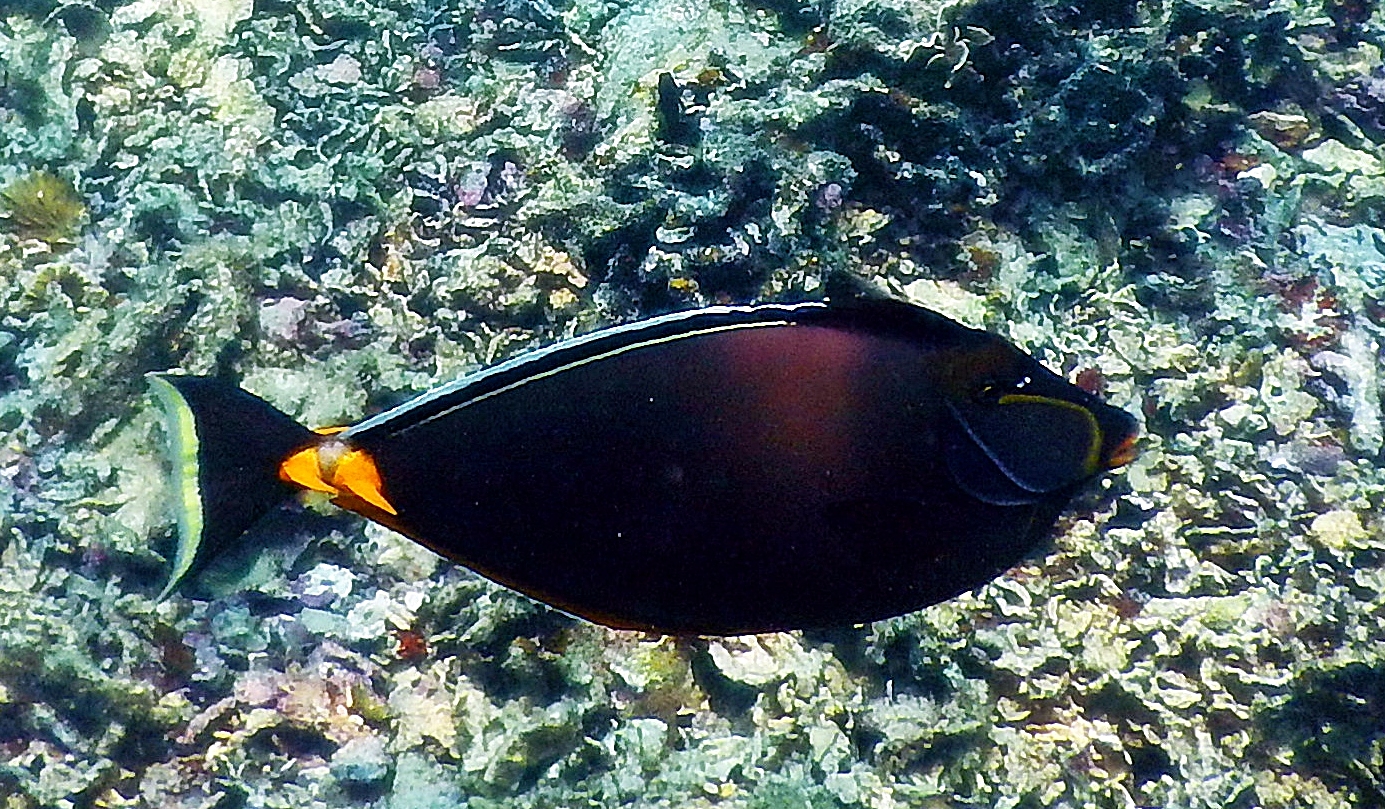
Commonly found around coral reefs, the orangespine unicornfish is easily recognized by the two bright orange flat spines at the base of its tail, which it uses to defend itself from predators, its orange lips, and the black mask on its face.
It feeds primarily on leafy brown algae.
The maximum length that individuals of this fish grow to is 46 cm.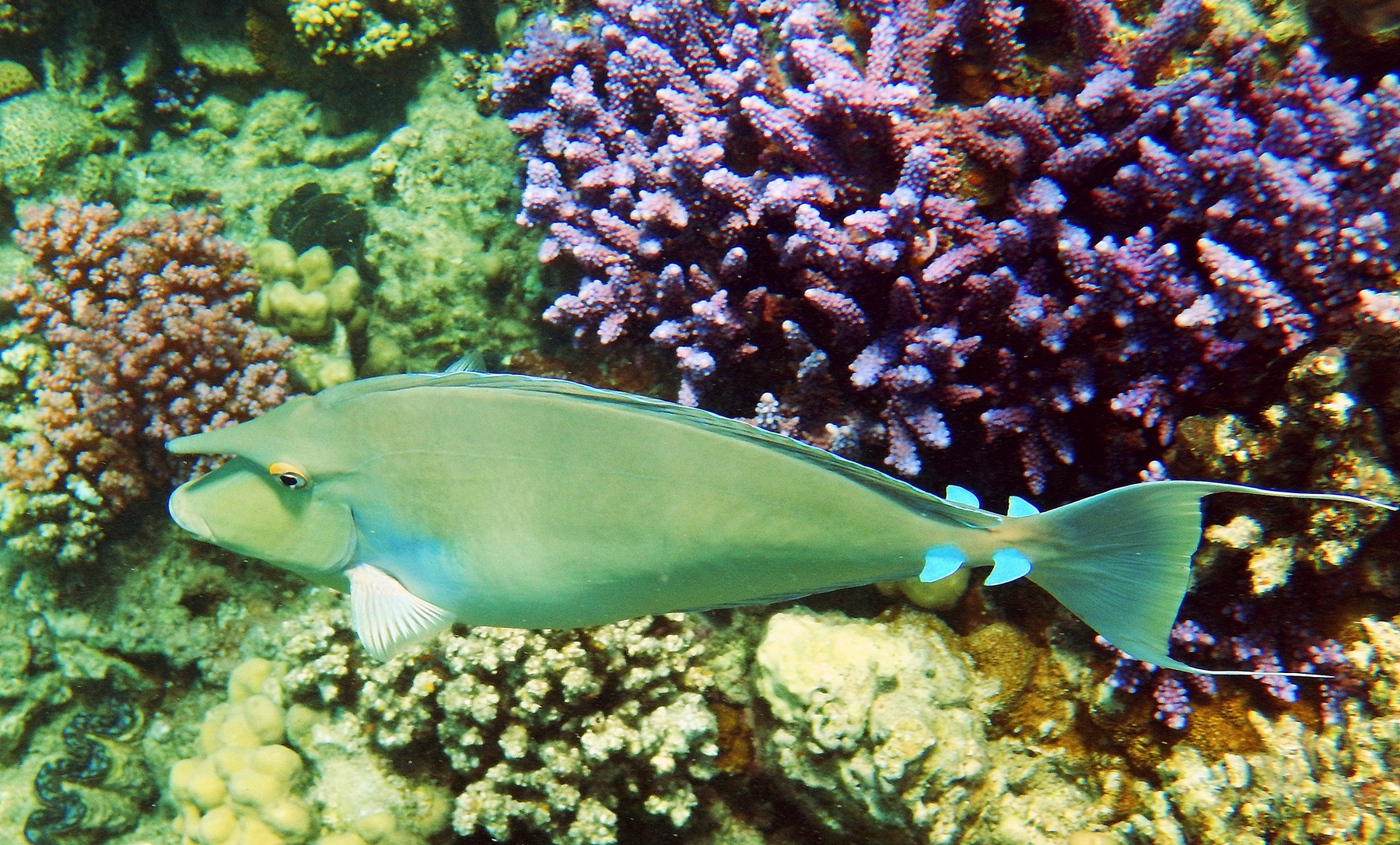
Bluespine unicornfish have an elongated, laterally compressed body and a caudal peduncle with two large, immobile, blue bony keel-shaped plates. The head of adult fish has a characteristic horn above the eyes.
The fish feed mainly on brown algae.
Naso unicornis grows up to 70 cm (28 in) in length.Moorish idol (Zanclus cornutus):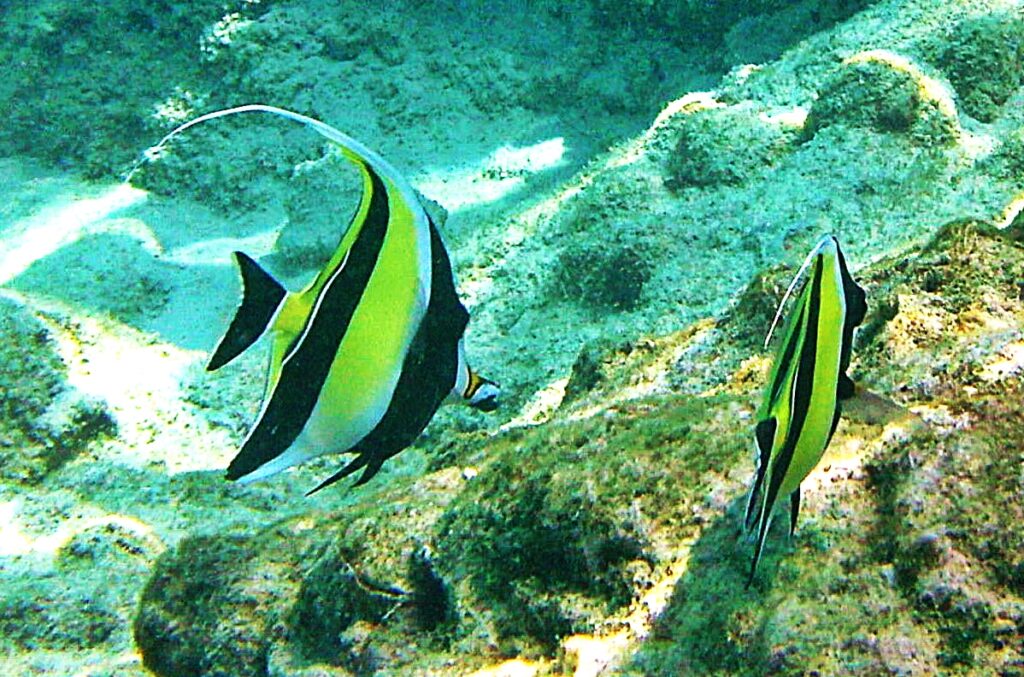
The Moorish Idol is a small reef fish with a maximum length of 23 cm, though they are typically around 21 cm long. This beautiful fish primarily feed on sponges, with gut contents analysis showing that sponges make up about 70% of the total body weight of food consumed, but Moorish idols also feed on algae, coral polyps, tunicates, and other benthic invertebrates, making them somewhat omnivorous.
They are usually found in small groups of 2 or 3 individuals, but may also be solitary or congregate in large schools.
Platax orbicularis (Orbicular batfish)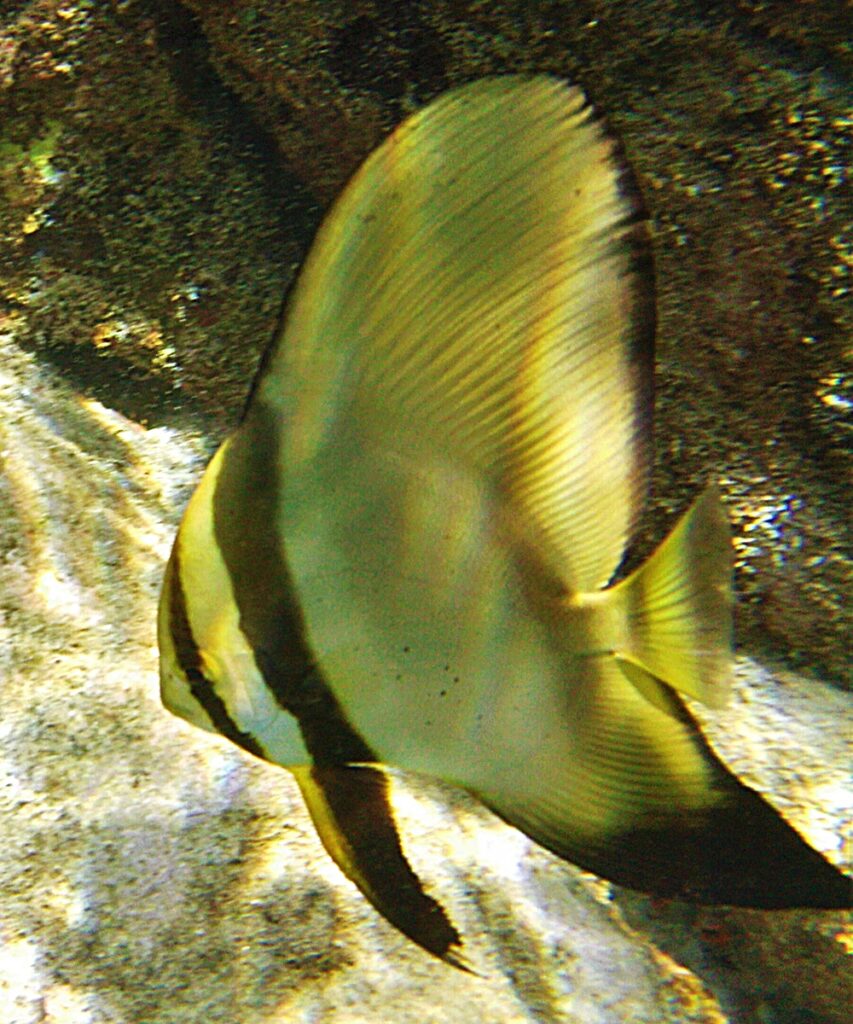
Juveniles and adults of Platax orbicularis are so different from each other that they have even been described as two different species. Juveniles, due to their very large anal and dorsal fins, have a crescent shape, as they mature their appearance changes and the body of adults is more rounded, flattened from the sides and quite high.
These fish are omnivorous, feeding on algae, small fish and invertebrates.
Platax orbicularis can grow to a maximum total length of 60 cm (24 in).
Order: Callionymiformes
Synchiropus splendidus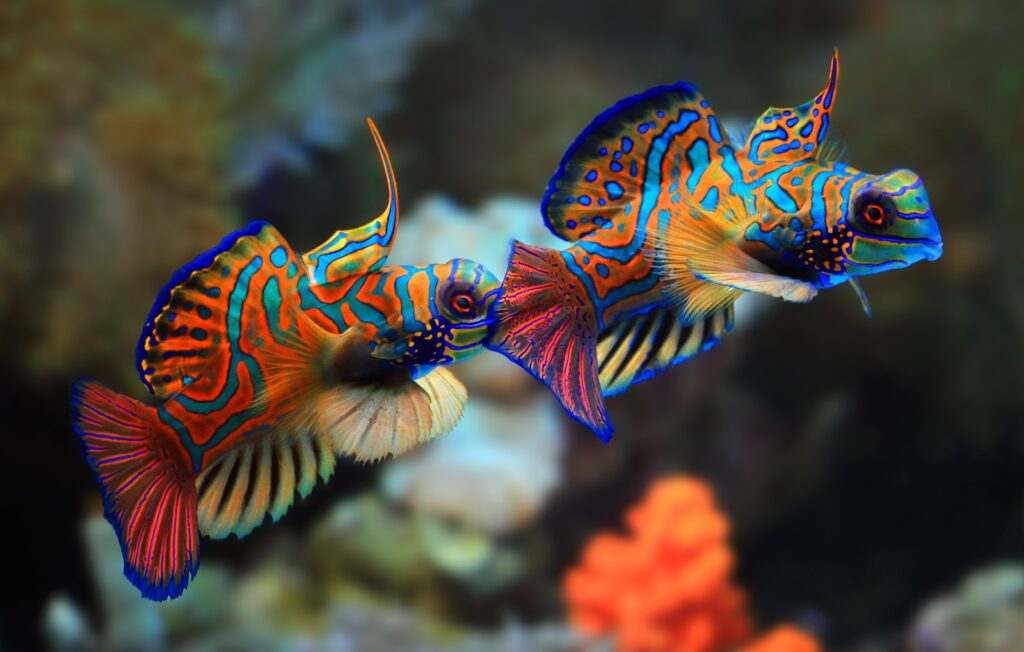
- Mandarin fish are undoubtedly one of the most beautiful inhabitants of coral reefs. Their incredible coloring, reminiscent of the patterns of oriental silk, makes them real underwater jewels.
But these fish are interesting not only for their appearance. One of the most amazing features of their life is the evening mating dances. With the onset of dusk, males and females rise above the reef, performing a complex and graceful ballet, which reaches its culmination at the time of spawning. - In addition to these romantic performances, mandarin fish also demonstrate an unusual way of moving. Instead of swimming, like most fish, they prefer to “walk” along the bottom, using their modified fins, like little paws. This allows them to slowly and methodically explore crevices in search of small invertebrates.
- And to protect themselves from predators, nature has endowed them with unique protection: the skin of mandarin fish is covered with poisonous mucus. This slime not only scares away potential enemies with its unpleasant taste, but is also toxic enough to make any predator think twice before attacking this colorful but dangerous fish.
- All these features make mandarins truly mysterious and attractive creatures of the underwater world.
- The Mandarin fish typically reaches a maximum length of 7 cm (2.8 inches).
Order: Tetraodontiformes
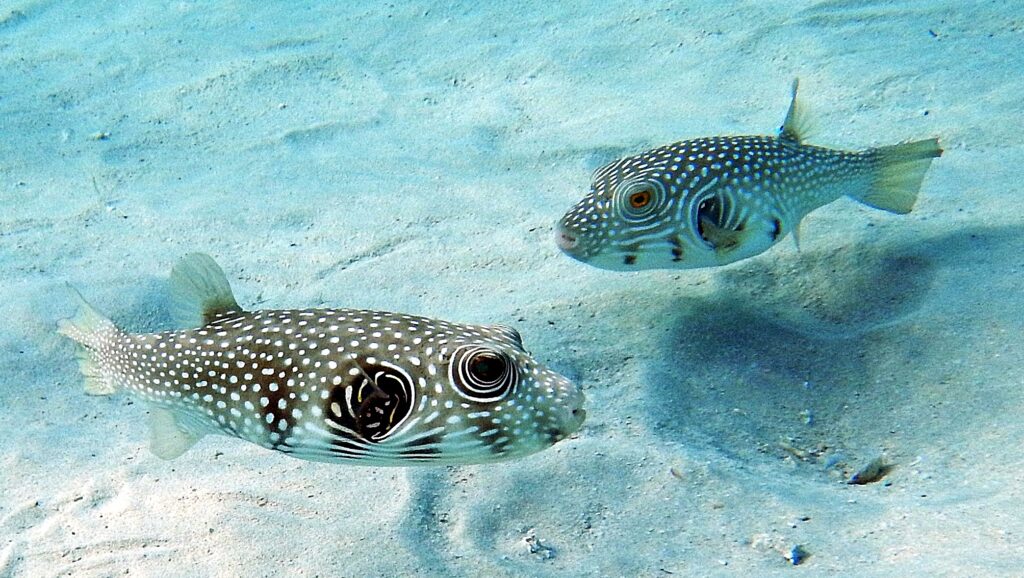
This fish can be found at depths ranging from three to 35 meters. Its habitat types include reefs, lagoons, estuaries, and tidal pools. Its diet includes calcareous or coralline algae, mollusks, tunicates, sponges, corals, zoanthids, crabs, polychaetes, starfish, urchins, krill, and silversides. Usually solitary and territorial on sandy to rubble areas.
Arothron hispidus, is a medium to large-sized pufferfish that can reach a maximum length of 50 centimeters (50 cm or 1.6 feet).

The body of Diodon Hystics is covered with spines that adhere to the body of the fish if the fish does not sense danger. When frightened, the porcupine fish swallows water or air, increasing in size, inflating like a balloon, and its sharp spines stand up straight, protecting it from predators.
This fish feeds mainly on sea urchins, mollusks and crustaceans, using its powerful jaws to crack the shells.
Diodon hystrix is a medium-sized fish, typically reaching 40 cm (16 inches) in length.
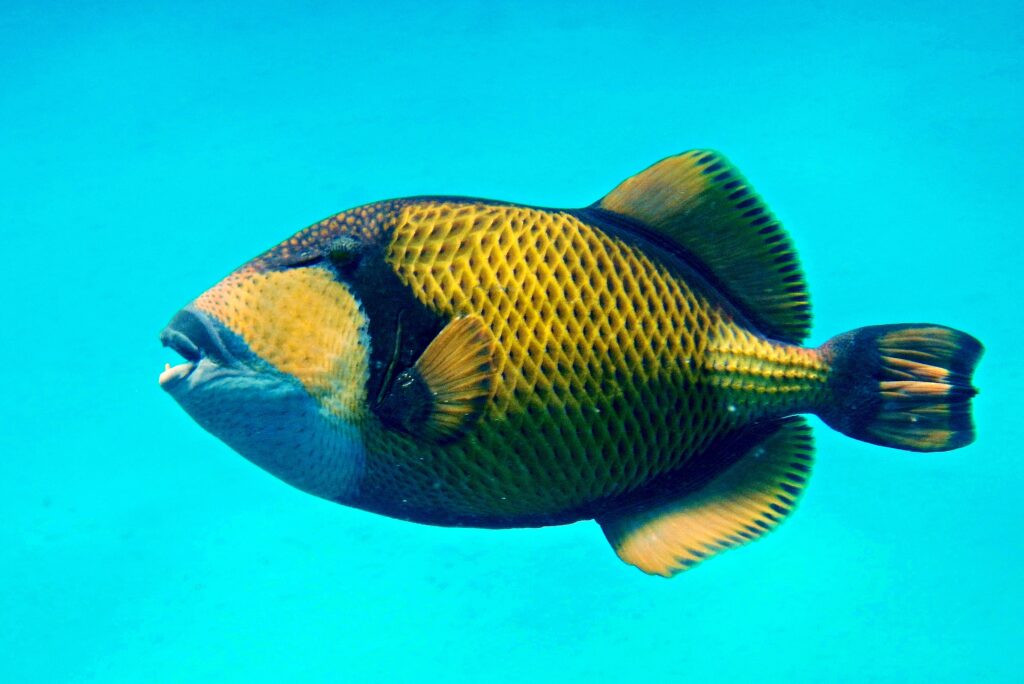
- Balistoides viridescens is the largest representative of the triggerfish family, its length is about 75 cm, and its weight is up to 10 kg.
- These fish live alone or in pairs in lagoons or on the outer slopes of reefs.
- Their diet includes madrepore corals, which the fish breaks off with a powerful jaw, as well as starfish, sea urchins, snails, polychaete worms and bivalves. The fish gets its prey, hidden in the sand, with the help of a powerful jet of water from its mouth.
- Female Balistodes viridescens very vigorously defend the area near the nest on the sea bottom from intruders. Therefore, there are many stories of these triggerfish attacking divers.
Balistoides conspicillum
(Clown Triggerfish)
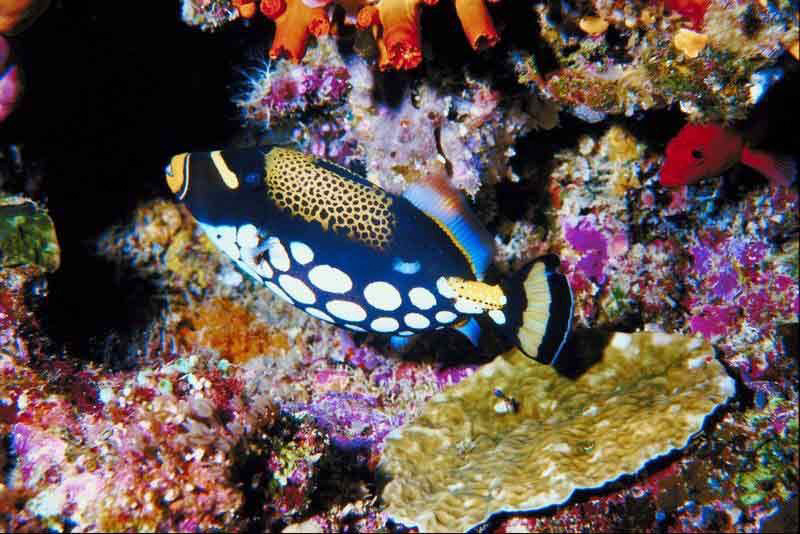
- Balistoides conspicillum lives in coastal coral reefs at depths of up to 75 meters. It is omnivorous, feeding on corals, mollusks, crustaceans and sea urchins.
- The clown triggerfish is a territorial, solitary fish that can be aggressive towards its own kind and other fish, especially when defending its territory or eggs.
- Balistoides conspicillum, can grow up to 50 cm (19.7 inches) in the wild
Pseudobalistes fuscus
(Blue Triggerfish)
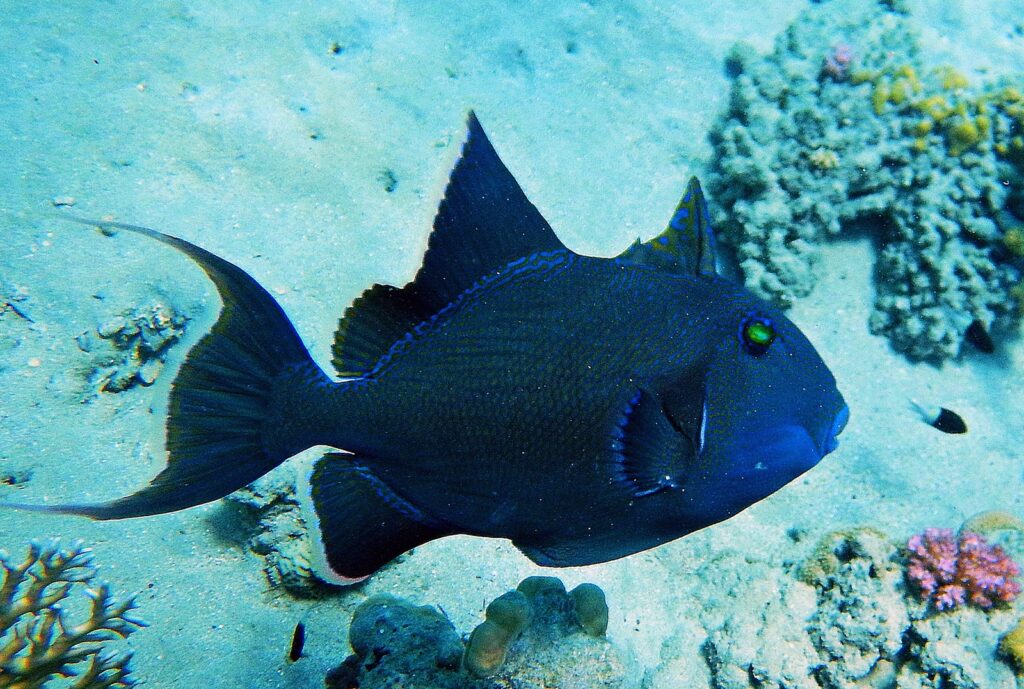
- The picture shows the triggerfish holding its spine upright.
- Pseudobalistes fuscus, can grow up to 55 centimeters (22 inches) in length.
- This fish is known for its aggressiveness and there are reports of blue triggerfish attacking divers.
Balistapus undulatus
(Orange-Lined Triggerfish)
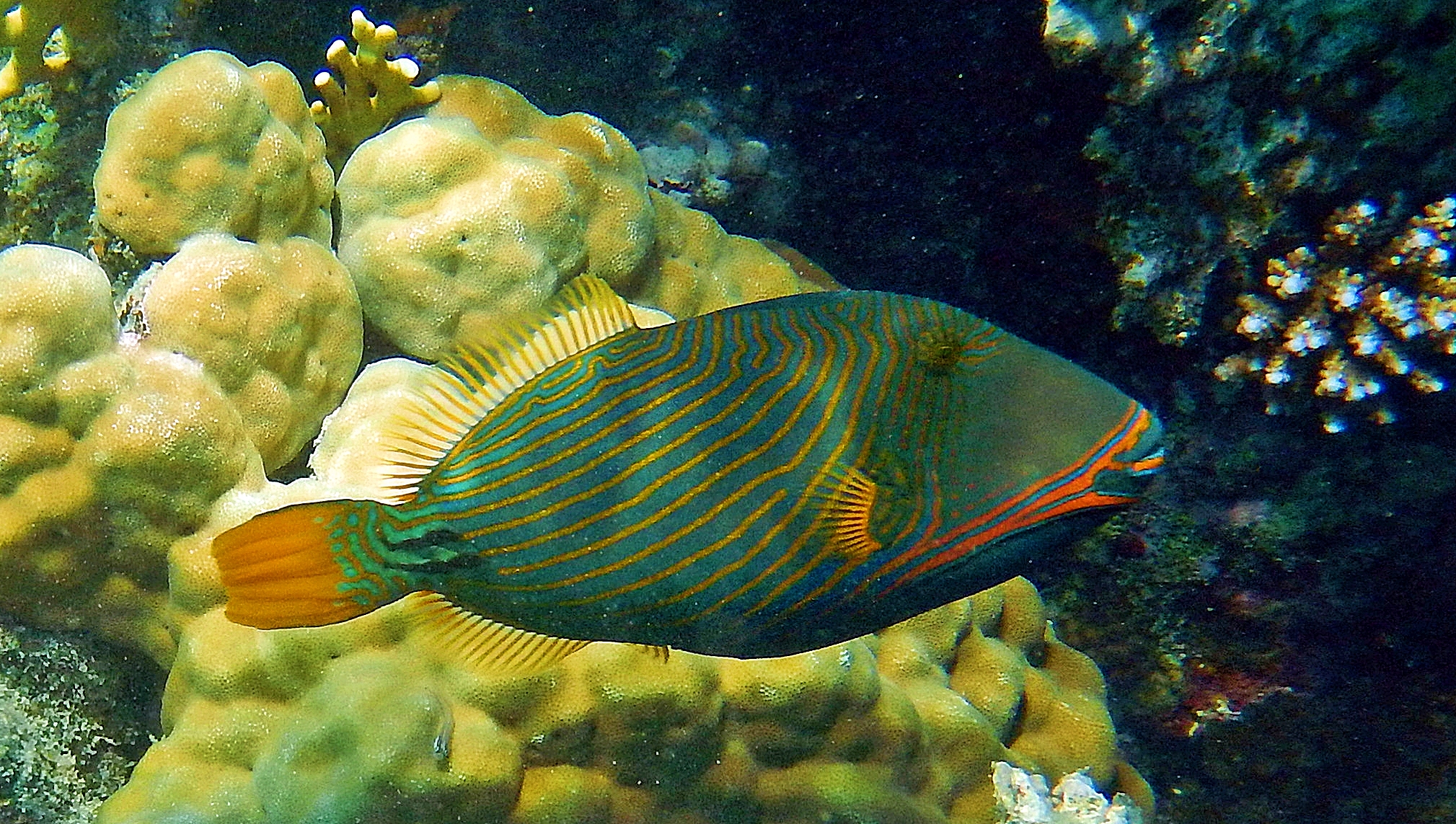
Orange-lined triggerfish are predators that feed on a variety of invertebrates, including corals and crustaceans.
Orange-banded triggerfish are considered to be one of the most aggressive members of the triggerfish family. They can be aggressive not only towards other fish, but also towards aquarists who care for them.
Like other triggerfish, Balistapus undulatus has a dorsal fin that can be fixed in a vertical position, allowing the fish to secure itself in crevices it crawls into and to protect itself from predators.
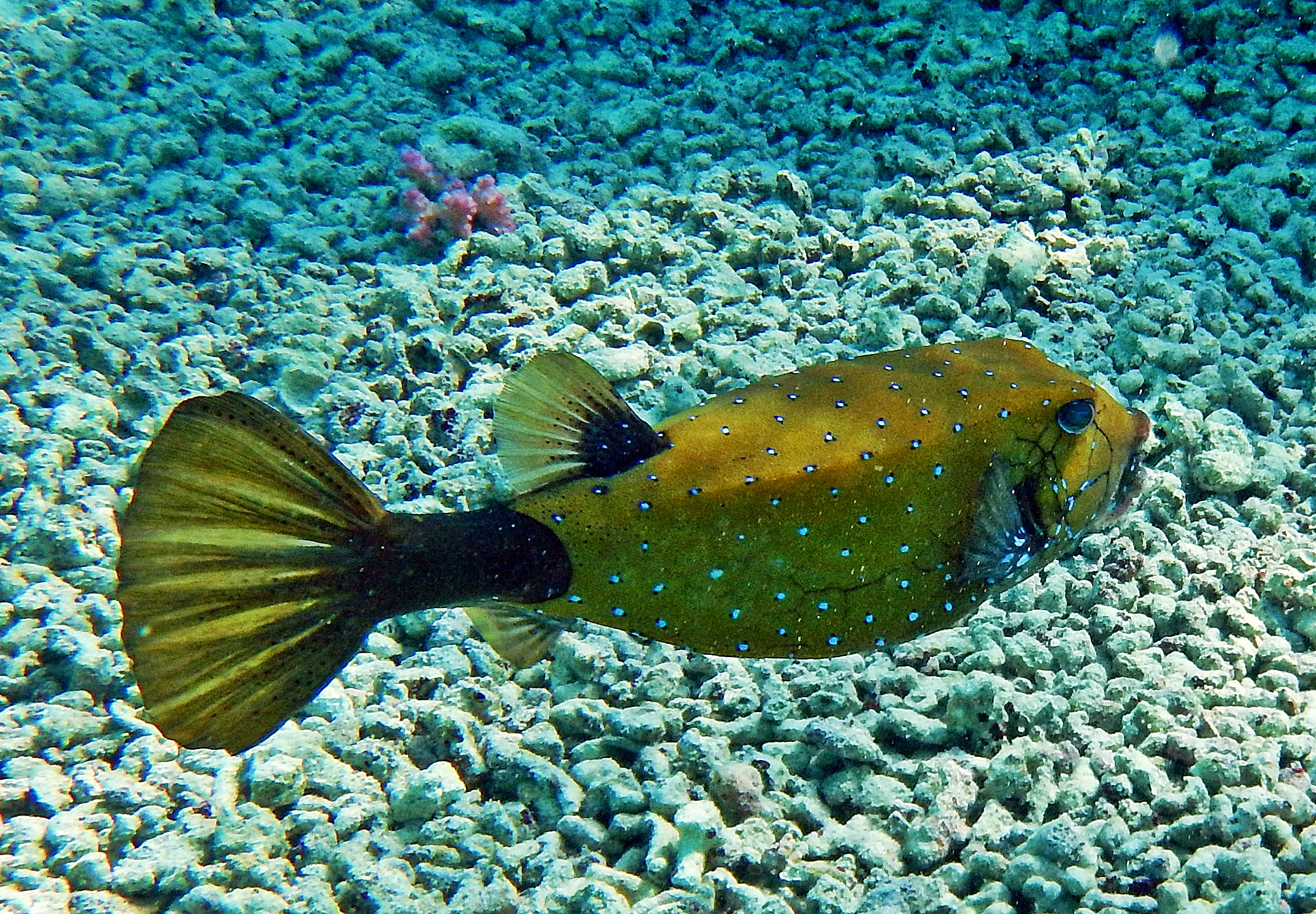
- The young fish have a bright yellow body with dark spots, while adults have a darker color with bright blue spots. It has a cubic body shape and secretes toxic mucus when threatened.
- The yellow boxfish’s diet consists mainly of benthic organisms and marine algae.
- Yellow boxfish can grow to a maximum length of 45 centimeters (18 inches).
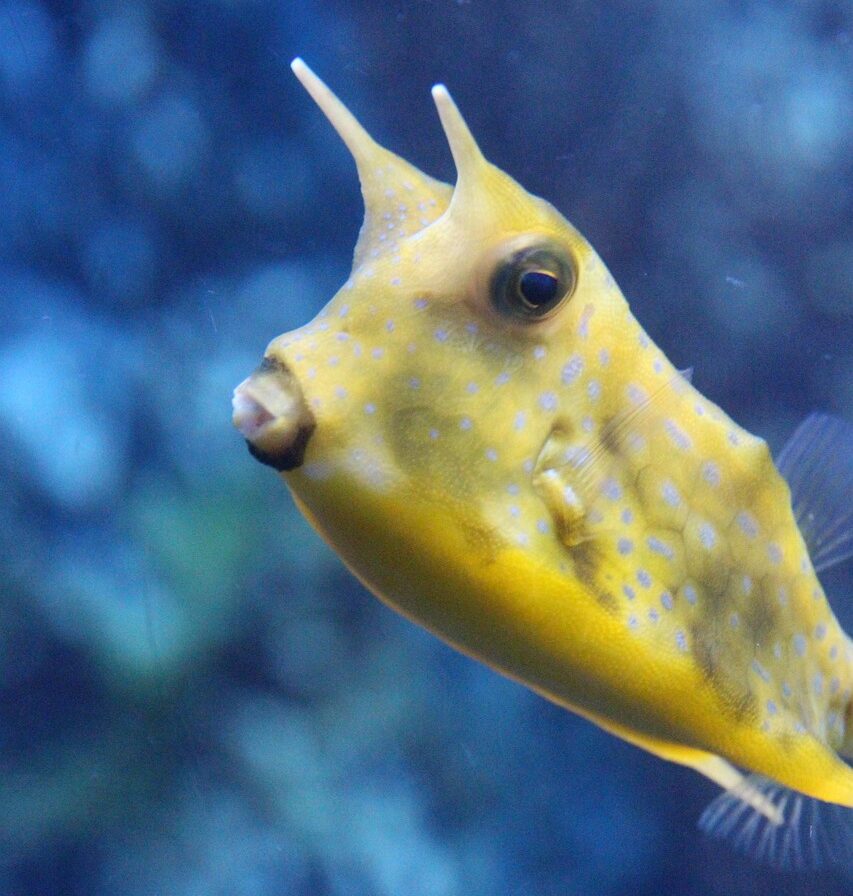
- The Longhorn cowfish’s primary habitat is coral reefs in lagoons, reef flats, estuaries, bays, and sheltered reefs facing the sea.
- They feed on bottom-dwelling invertebrates by stirring up sand.
- When severely stressed, the cowfish can secrete a deadly toxin from its mucous skin.
- The usual size of this fish is about 40 centimeters in length.
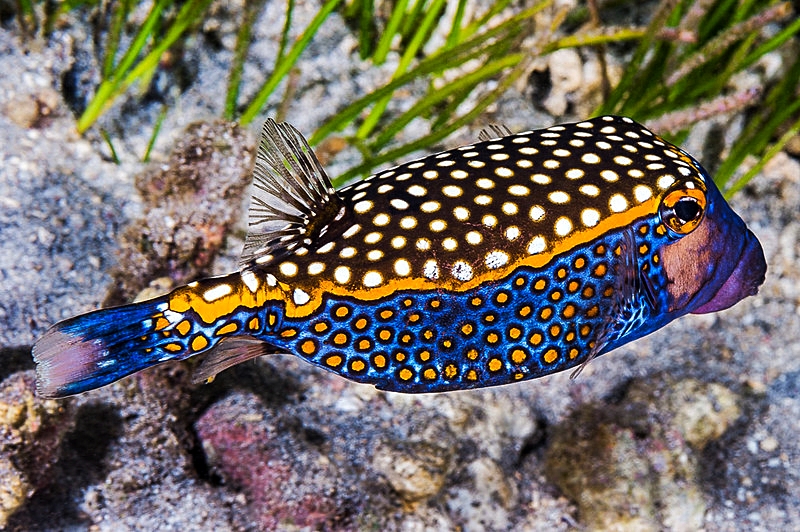
- The spotted boxfish inhabits clear lagoons and seaward reefs from the lower intertidal zone to depths of at least 30 metres.
- Juveniles live among rocky boulders, often with long-spined urchins, while adults live on reef ridges and slopes. Males swim more openly than females, which are often found in close proximity.
- Ostracion meleagris feeds on tunicates, polychaetes, sponges, mollusks, copepods and algae.
- Ostracion meleagris, reaches a maximum length of 25 centimeters (9.8 inches).
Aluterus scriptus (Scrawled Filefish)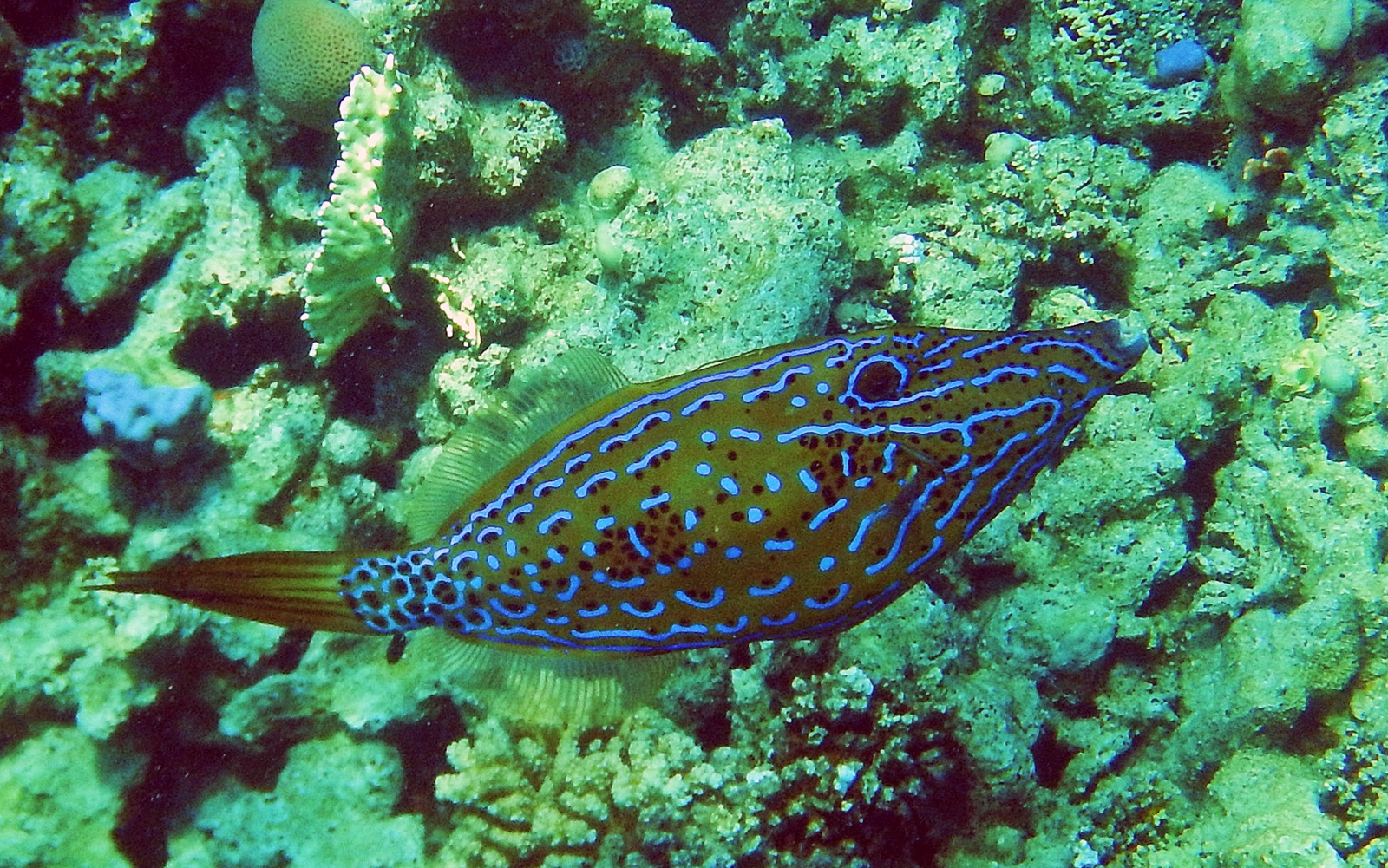
- Aluterus scriptus is omnivorous and feeds on a wide range of animals, including small crustaceans, algae, gorgonians, anemones, tunicates, fire corals, sea grasses, and hydroids.
- The body coloration of this fish can change rapidly depending on the background, similar to the coloration of an octopus.
- It contains palytoxin, which is fifty times more toxic than tetrodotoxin, the poison of pufferfish.
- Aluterus scriptus is a medium-sized fish that can grow up to 110 cm (3.6 ft) in length
Order: Anguilliformes (eels)
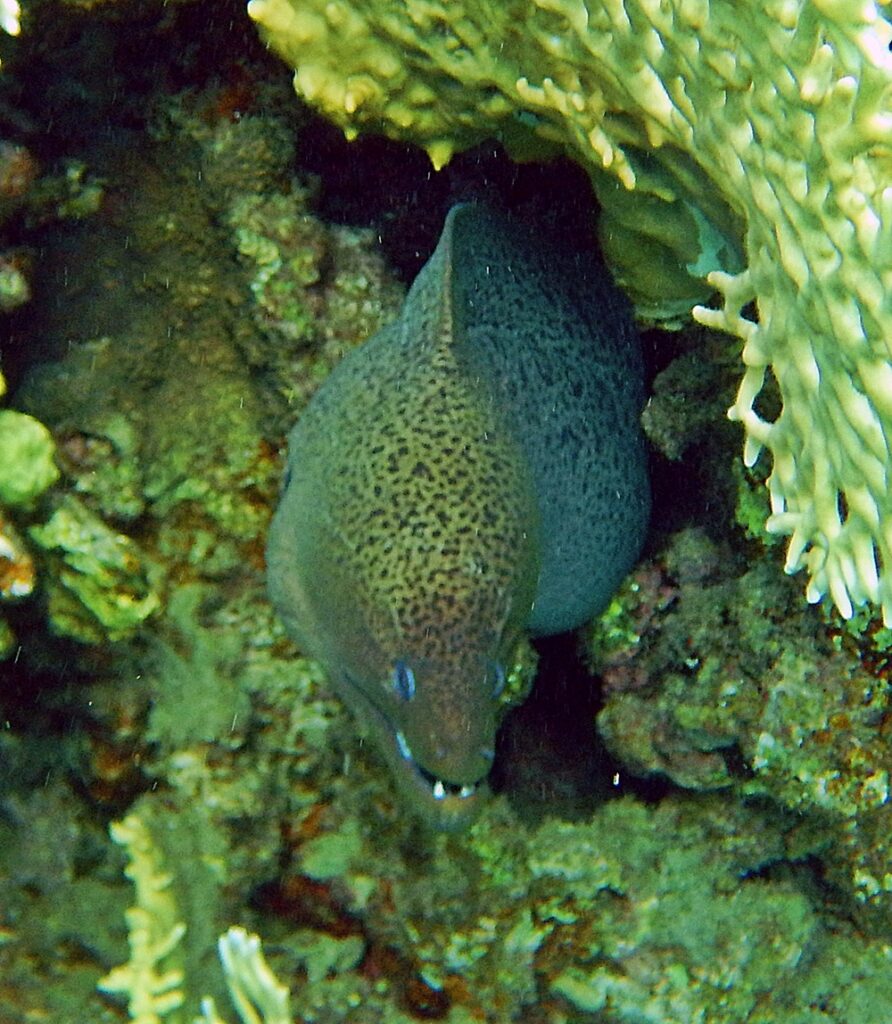
Gymnothorax javanicus is a true legend of the coral reefs! When it leaves its shelter and glides past like an underwater dragon, the sight is mesmerizing. This moray eel can reach a length of up to 3 meters and a weight of up to 30 kg.
The giant moray eel leads a solitary life, hiding in crevices during the day and going out to hunt at night. It feeds on any fish, cephalopods or large crustaceans that it can catch. Gymnothorax javanicus prefers to live alone and guards its territory. This fish is capable of cooperation – there are known cases of joint hunting with sea bass (Plectropomus pessuliferus), with which it then shares its prey.
The giant moray eel is considered an aggressive fish and, although it does not attack without reason, it can bite if it feels threatened – the bite is very painful. There are recorded cases of these fish attacking divers.
Class: Chondrichthyes (cartilaginous fish)
Order: Orectolobiformes
Rhincodon typus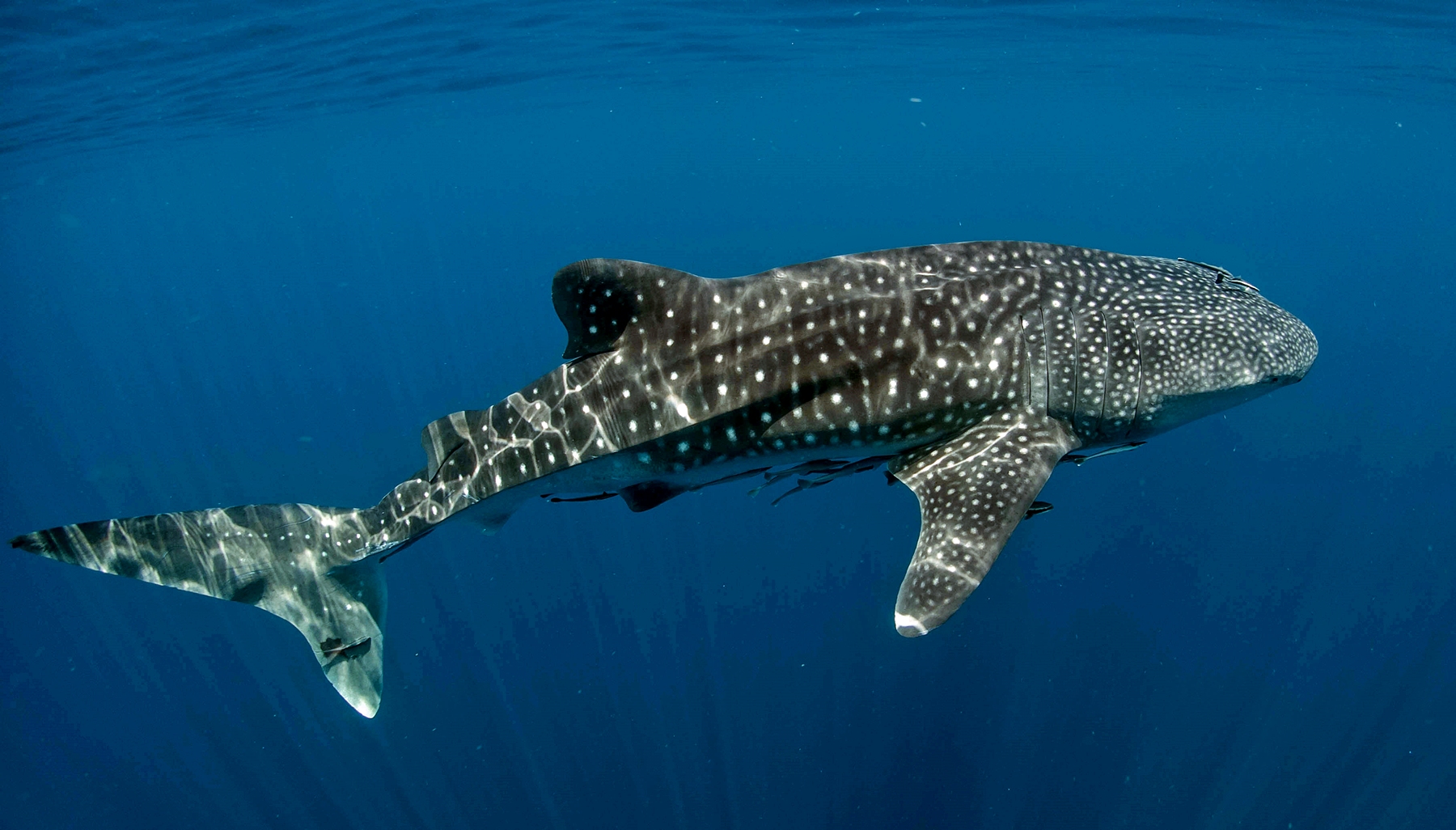
- The largest fish in the world. The length of Rhincodon typus is 9-10 meters.
- It feeds on plankton and small fish, filtering water through its mouth, and is completely safe for humans.
- Of course, when swimming next to such a large fish, you need to be prudent so as not to end up next to the tail and not get an accidental tail hit.
- The whale shark is a rare species whose numbers are constantly declining due to ongoing fishing, including poaching.
Nebrius ferrugineus (Tawny Nurse Shark)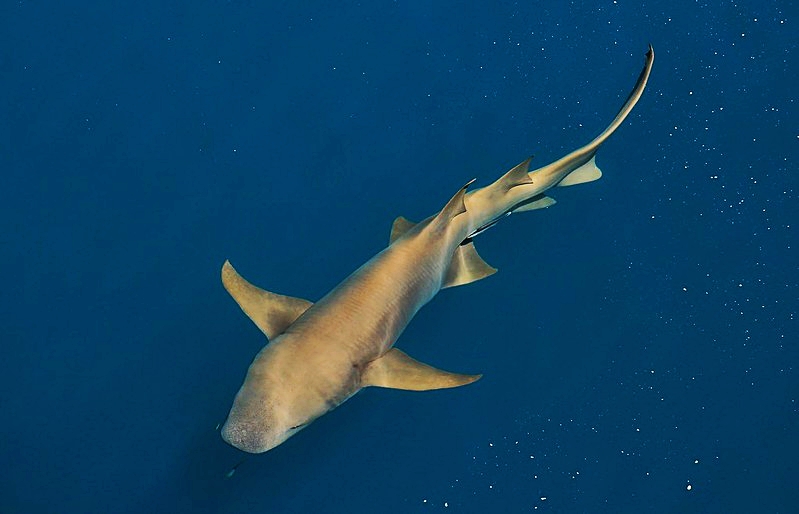
- The tawny nurse shark typically spends the day resting in groups of two dozen or more individuals in caves or under ledges. At night, it is an active predator, using powerful suction to extract prey from holes and crevices.
- This species’ diet consists primarily of octopuses, although they will also eat other invertebrates and small bony fish.
Nebrius ferrugineus is aplacental viviparous, meaning the embryos hatch from egg capsules inside the mother. - Docile and generally harmless to humans, typically found resting on the sea floor.
- According to FishBase, males reach sexual maturity at around 2.25 meters (7.4 feet) and females at about 2.3 meters (7.6 feet).
Order: Carcharhiniformes
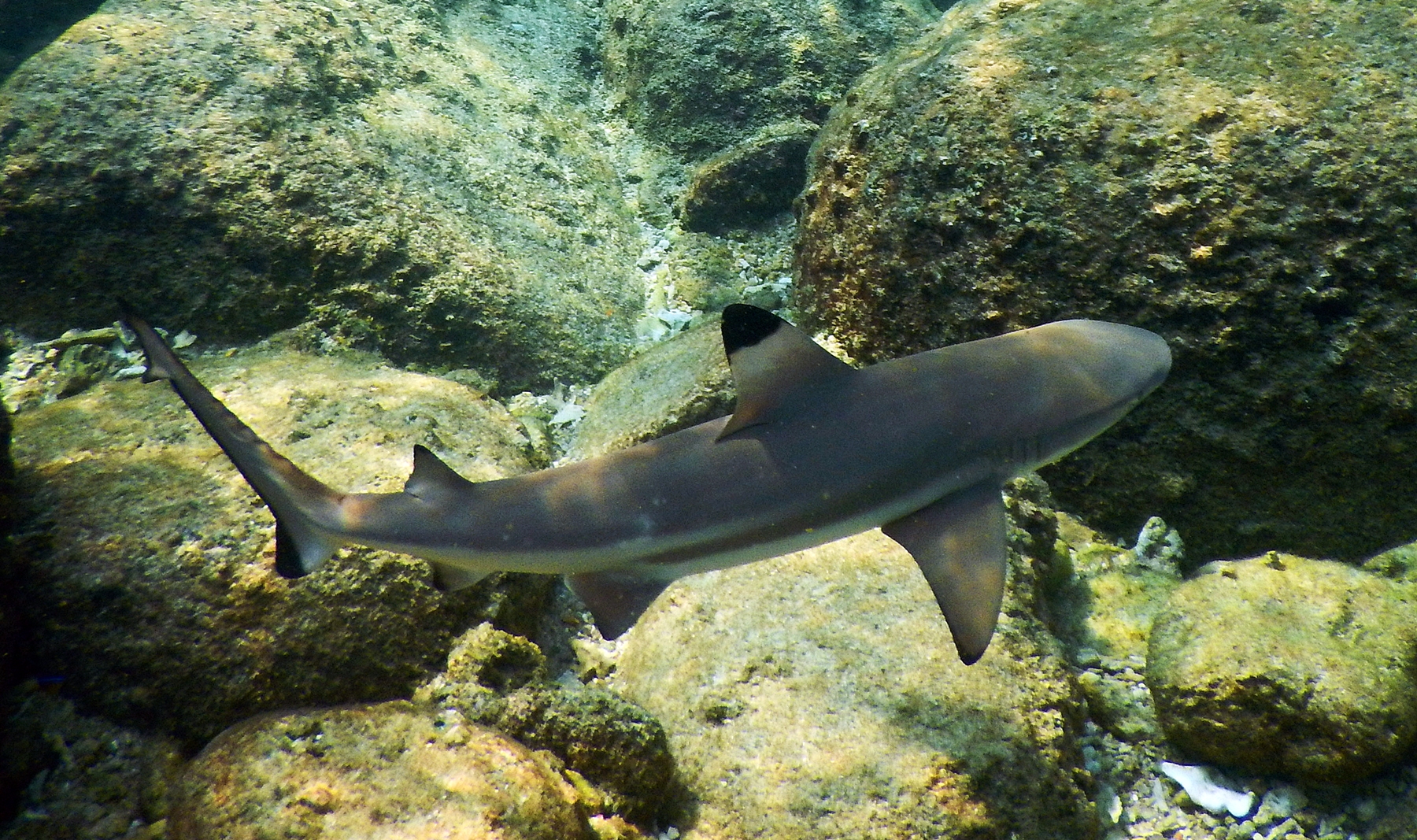 Carcharhinus melanopterus is commonly found on reef ledges and sandbanks, preferring shallow coastal waters.
Carcharhinus melanopterus is commonly found on reef ledges and sandbanks, preferring shallow coastal waters.- It is an active predator, feeding on small bony fish, cephalopods, and crustaceans, but is not dangerous to humans. These fish can be curious, but do not attack swimmers – it is interesting to swim with them in shallow water.
- The blacktip reef shark typically reaches a length of 1.6 m (5.2 ft).
Order: Myliobatiformes
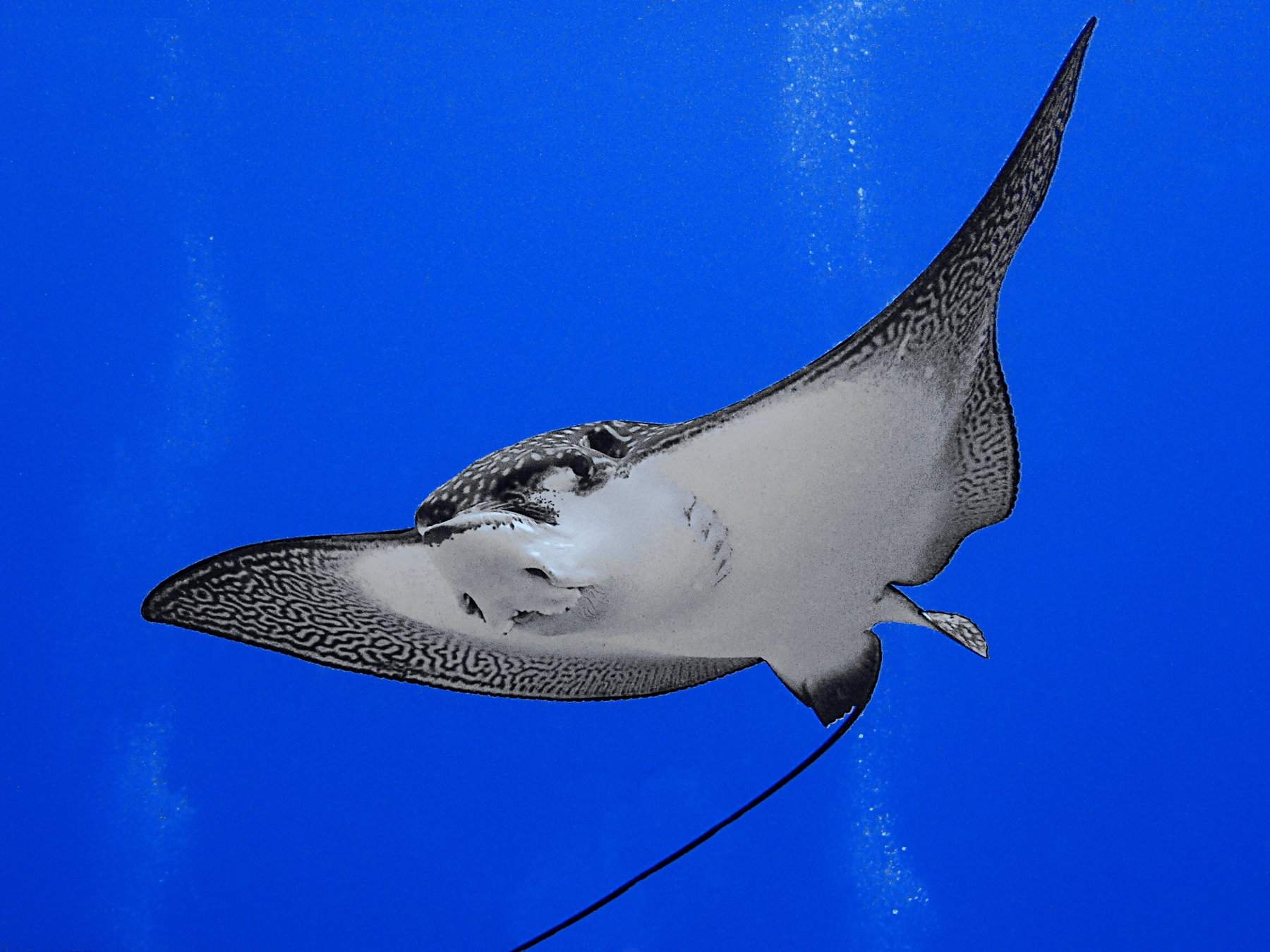
- Eagle rays tend to be found in shallow coastal waters with coral reefs and bays. They enter lagoons and river estuaries. They are found from the surface to a depth of 80 m. These fish lead a solitary lifestyle, but can form schools of up to several hundred individuals.
They spend most of their time swimming freely close to the surface. - Aetobatus narinari feed mainly on bivalves, including heterodonts, shrimp, crabs, gastropods and other benthic organisms.
- Although spotted eagle rays usually avoid encounters with scuba divers, they still pose a potential danger due to the presence of poisonous spines at the base of the tail.
- Aetobatus narinari is a large ray species with a maximum disc width of 3 meters (9.8 feet) and a maximum total length (including the tail) of up to 5 meters (16.4 feet).
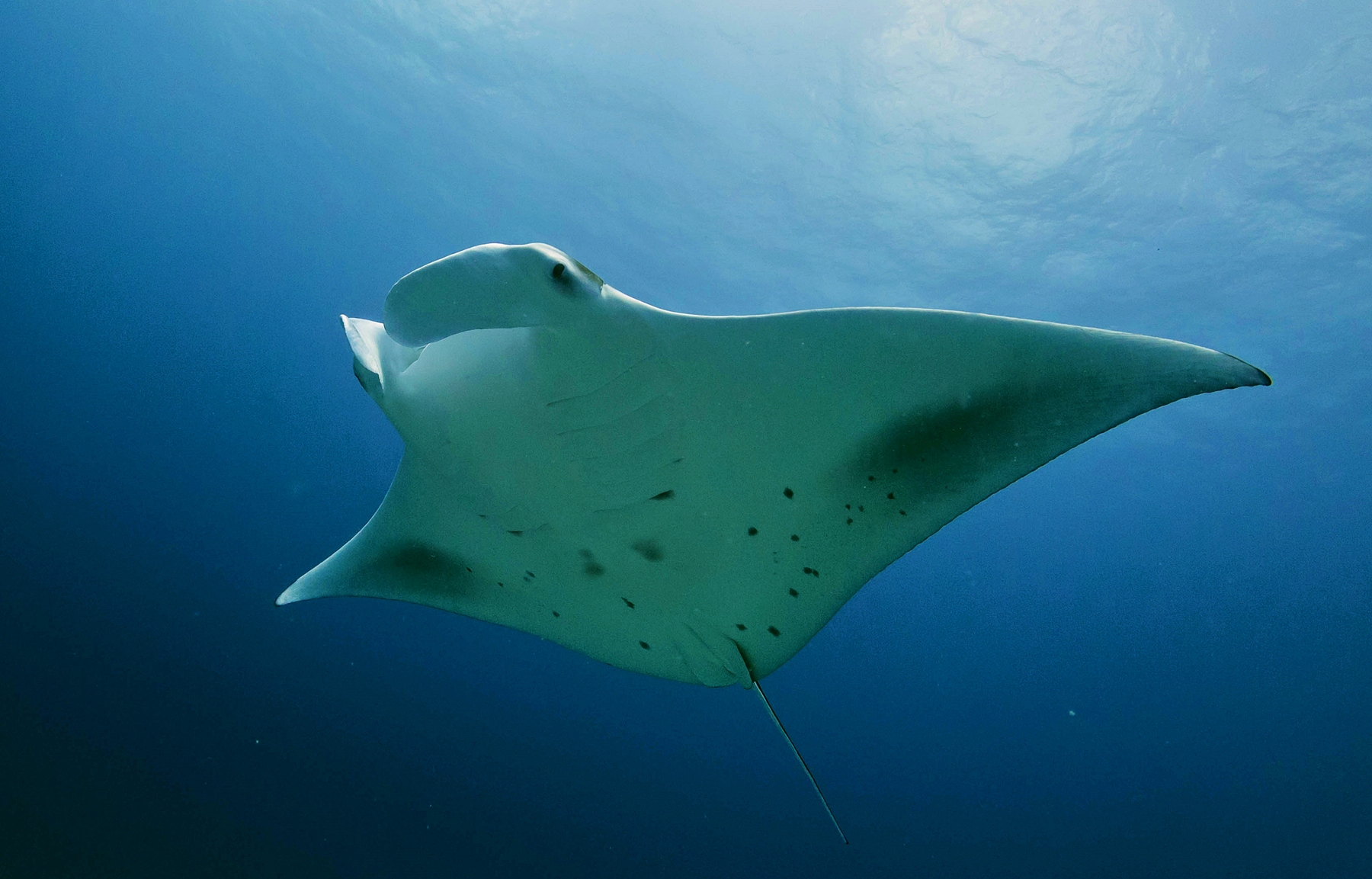
Manta alfredi swim by flapping their pectoral fins like wings.
The average size of Manta alfredi is usually between 3 and 3.5 meters.
Mantas feed on zooplankton, fish larvae, and sometimes can feed on small fish. When feeding, mantas slowly swim around their prey, compacting it into a lump, and then speed up and swim with an open mouth through the accumulation of organisms. The cephalic fins, usually twisted into a spiral tube, unfold during feeding. The rays use them to direct food into their mouths.
Mantas do not pose a danger to people. But man is a huge threat to these fish: the main threat to the giant manta ray is commercial fishing, in which this species is the object of hunting and bycatch in a number of fishing zones around the world.Unfortunately, scientists warn that coral reefs are on the brink of extinction. Climate change, rising ocean temperatures, pollution, acidic waters, and overfishing are all causing mass coral bleaching and death. Some studies predict that up to 90% of coral reefs could disappear by 2050 unless urgent action is taken.
But there is a silver lining in this grim picture:
🧬 Biotechnology is helping to create warming-resistant coral species.
🧪 Lab-breeding and transplanting corals into damaged areas is already yielding results.
🧱 The creation of artificial reefs that serve as a refuge for marine organisms and a basis for the development of young corals..
🌍 Rehabilitation of damaged reefs.
So perhaps we are not the last generation destined to see the beauty of the reefs, but a transitional one: between the era of destruction and the era of restoration. It all depends on how ready humanity is to act.
Thanks for reading!
If you like it, please, read another blog – about Cambodia.

